History
Varney was a United States manufacturer of model railroad equipment.
 The Company was founded by Gordon Varney in 1936 in Chicago, IL. Varney's main significance to the model railroad
community was his early advocacy of the HO scale (3.5mm to the foot) and the development of a reliable V-1 6 volt motor small
enough to power the locomotives of this gauge, and to pull a nice sized consist.
Varney's catalogs were vivid, informative and contained editorials and fascinating exploded views that
clearly show an understanding of the mind of model railroaders that still rings true today.
The Company was founded by Gordon Varney in 1936 in Chicago, IL. Varney's main significance to the model railroad
community was his early advocacy of the HO scale (3.5mm to the foot) and the development of a reliable V-1 6 volt motor small
enough to power the locomotives of this gauge, and to pull a nice sized consist.
Varney's catalogs were vivid, informative and contained editorials and fascinating exploded views that
clearly show an understanding of the mind of model railroaders that still rings true today.
Like so many other model train business founders, Gordon Varney started out as a hobbyist. Varney
appreciated the fact that you could get 10 hours of entertainment putting together a freight car construction kit for
a $2 bill investment. After assembling a dozen kits he had purchased, he looked at his wife and said, "there should be a
business here". According to an interview with Varney that appeared in the February 1953 issue of Popular Science magazine,
"That was when a perfectly good hobby went out the window. We soon found that there is no such thing as a hobby-business. To
pay off, it has to be your business and the other fellow's hobby."
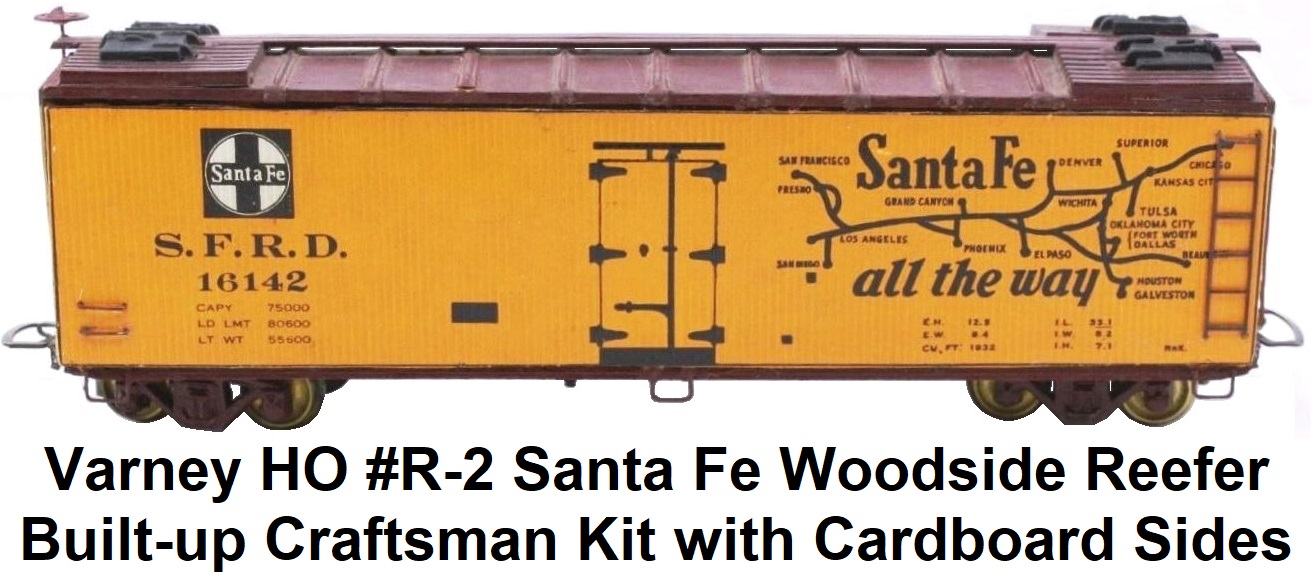
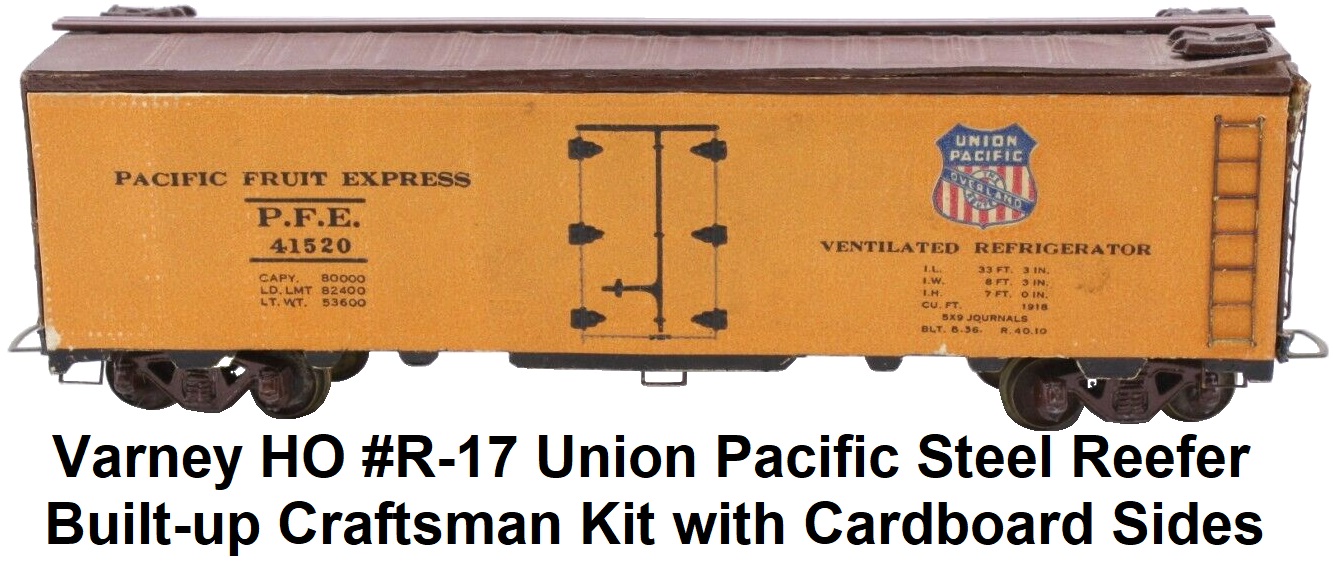
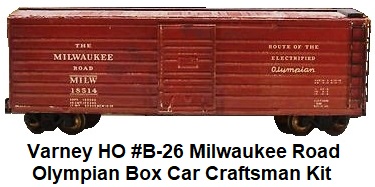 In 1936 Varney began manufacturing his HO kits made of paper and wood. The box cars had paper
sides which were photographically reproduced from pictures he took in the Los Angeles railroad yards.
These early freight cars, including reefers, were pre-printed and sold with the slogan "No paint needed."
The photo engraved details of the doors and lettering appeared on the paper, which was then glued to cardboard sides.
To make them more prototypical, modelers could glue cast or wooden details directly on the printed cardboard in places where
these details would appear, such as roof ribs, grab irons, ladders, ice hatches and brake wheels, in order to give dimension
and depth to the cars. Varney believed that his business was to produce miniatures that would not insult one's imagination by
failing to resemble the real thing.
In 1936 Varney began manufacturing his HO kits made of paper and wood. The box cars had paper
sides which were photographically reproduced from pictures he took in the Los Angeles railroad yards.
These early freight cars, including reefers, were pre-printed and sold with the slogan "No paint needed."
The photo engraved details of the doors and lettering appeared on the paper, which was then glued to cardboard sides.
To make them more prototypical, modelers could glue cast or wooden details directly on the printed cardboard in places where
these details would appear, such as roof ribs, grab irons, ladders, ice hatches and brake wheels, in order to give dimension
and depth to the cars. Varney believed that his business was to produce miniatures that would not insult one's imagination by
failing to resemble the real thing.
 One of Varney's early employees was Bob Lindsay who created the first two locomotives.
Varney offered the 4-6-2 Pacific and the 2-8-0 Consolidation in the late 30's, through the early 40's. Early sales and
distribution was all done via mail order. The majority of the products manufactured were kits. The loco kits consisted of
one piece brass castings (cab, stack domes, and running boards) and pressure die-cast zinc alloy parts, using a material
called Zamak. Other detail fittings and piping were made of sheet metal and brass, while the early rolling stock kits were
wood, paper and metal. Parts and fittings could all be purchased separately. HO scale was just beginning when these famous
locomotives made their appearance. The Pacific featured the USRA boiler style and was patterned after the Southern Pacific
prototype. There were about 120 parts in the Pacific kit. Instruction sheets with comprehensive pictorial assembly steps
shown were included in the kits. The Consolidation was designed after the Reading 2-8-0. Soon the 2-8-2 Mikado followed, and
other models were added to the line. These trains were high quality, and this is attested to by the fact
that original models are still in operation today. The early Varney locomotives appear somewhat rough and less
detailed compared to the modern day mass-produced, laser painted, machine lettered, DCC and sound equipped models
readily offered. But, for their time period the Varney products were good looking accurate models and were also of high
quality, were dependable and rugged.
One of Varney's early employees was Bob Lindsay who created the first two locomotives.
Varney offered the 4-6-2 Pacific and the 2-8-0 Consolidation in the late 30's, through the early 40's. Early sales and
distribution was all done via mail order. The majority of the products manufactured were kits. The loco kits consisted of
one piece brass castings (cab, stack domes, and running boards) and pressure die-cast zinc alloy parts, using a material
called Zamak. Other detail fittings and piping were made of sheet metal and brass, while the early rolling stock kits were
wood, paper and metal. Parts and fittings could all be purchased separately. HO scale was just beginning when these famous
locomotives made their appearance. The Pacific featured the USRA boiler style and was patterned after the Southern Pacific
prototype. There were about 120 parts in the Pacific kit. Instruction sheets with comprehensive pictorial assembly steps
shown were included in the kits. The Consolidation was designed after the Reading 2-8-0. Soon the 2-8-2 Mikado followed, and
other models were added to the line. These trains were high quality, and this is attested to by the fact
that original models are still in operation today. The early Varney locomotives appear somewhat rough and less
detailed compared to the modern day mass-produced, laser painted, machine lettered, DCC and sound equipped models
readily offered. But, for their time period the Varney products were good looking accurate models and were also of high
quality, were dependable and rugged.

Varney locomotives in the 1930's utilized the V-1 permanent magnet motor. It featured an Alnico horseshoe
tunnel type magnet with integral pole pieces. It had a 3 pole armature and worm drive. It had an exposed brush holding
rigging and was designed specifically for the Varney pre-war era steam locomotives with the die-cast zamack frame. This type
of electric motor operates on DC power only, with an operating range of 4 to 8 volts at ½ to 1½ amperes.
Alternating current could damage such a motor. This open frame motor was developed by Bob Lindsay. Literature from Varney
boasted that these motors were commercial grade, not a toy. And that they would stand up under heavy, continuous service. The
locomotives were designed specifically for prototypical 2-rail operation, with insulated wheel sets on all cars.
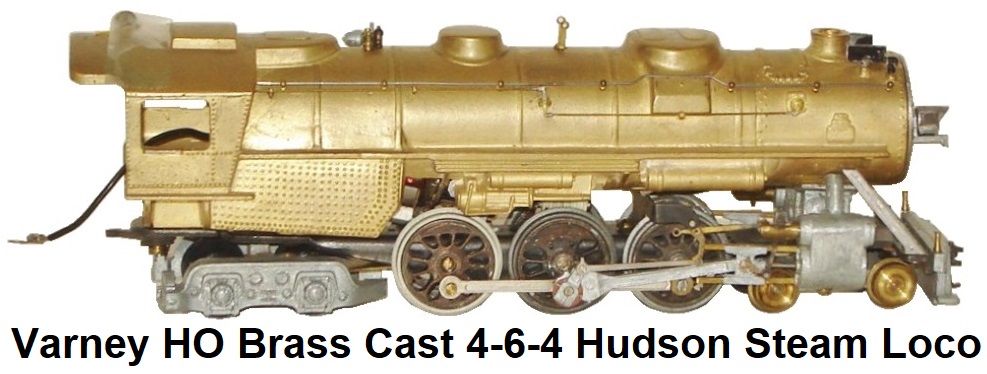 Gordon Varney earned the name 'Dean of HO' as a result of the multitude of innovations he created. One
such was in 1939 when he produced his HO locomotives with fully sprung chassis created by use of a simple dual wire spring
system. Through close work with Robert Lindsay, motors and gearboxes were designed that were fully floating, with all sprung
wheels on most models. In the mid-1950's this technique was dropped due to cost considerations.
Gordon Varney earned the name 'Dean of HO' as a result of the multitude of innovations he created. One
such was in 1939 when he produced his HO locomotives with fully sprung chassis created by use of a simple dual wire spring
system. Through close work with Robert Lindsay, motors and gearboxes were designed that were fully floating, with all sprung
wheels on most models. In the mid-1950's this technique was dropped due to cost considerations.

 The locomotive kits produced by Varney were not for the faint of heart, and required reading the
instructions carefully to complete a build successfully. Varney wrote the instructions in a wry style, replete with sarcasm,
jokes and even insults. An example from the Varney Rigid Frame HO Berkshire Locomotive kit warned, "CAUTION! This is a
hobbyist's construction kit. In the interests of economy, the small drilling operations on the boiler are left to the
constructor. MOST MODEL RAILROADERS can drill a hole. If you are “not the type” - DON'T BUY THIS KIT! Remember
that although [the] mechanism is ready-to-run as soon as the wheels are attached, this kit requires some mechanical gumption
to make a good locomotive model. If you are new at the game, READ THE INSTRUCTIONS, because an otherwise good kit can be made
into junk in jig time".
The locomotive kits produced by Varney were not for the faint of heart, and required reading the
instructions carefully to complete a build successfully. Varney wrote the instructions in a wry style, replete with sarcasm,
jokes and even insults. An example from the Varney Rigid Frame HO Berkshire Locomotive kit warned, "CAUTION! This is a
hobbyist's construction kit. In the interests of economy, the small drilling operations on the boiler are left to the
constructor. MOST MODEL RAILROADERS can drill a hole. If you are “not the type” - DON'T BUY THIS KIT! Remember
that although [the] mechanism is ready-to-run as soon as the wheels are attached, this kit requires some mechanical gumption
to make a good locomotive model. If you are new at the game, READ THE INSTRUCTIONS, because an otherwise good kit can be made
into junk in jig time".
By 1939 Varney was using stamped metal, in either aluminum or thin sheet brass for the box car sides
and ends in what was promoted as 'Super Detail' car kits. The aluminum sides came painted and lettered, while the brass ones
were unpainted, and the metal parts had a gummed backing to fasten them to the wood frames. Another Varney innovation was
embossed aluminum car sides. Embossing allowed even more detail, such as rivets. In 1939, complete Varney 'Super Detail' box
car kits sold for $1.75. Side and end sets only, were priced at 35¢ The 1939 Varney Catalog proclaimed, "New! Super
Detail Embossed Box car side and end sets ...so sharp and clear that even the rivets cast sunlight shadows."
Varney private Owner Woodside Billboard Reefer Kits

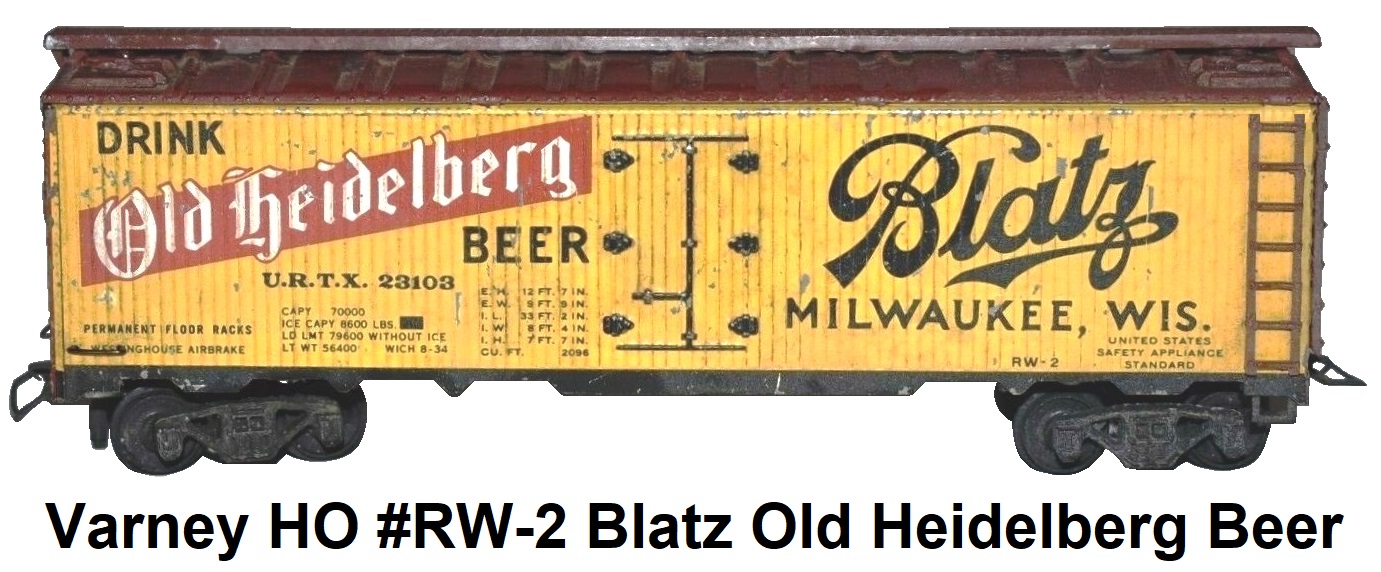
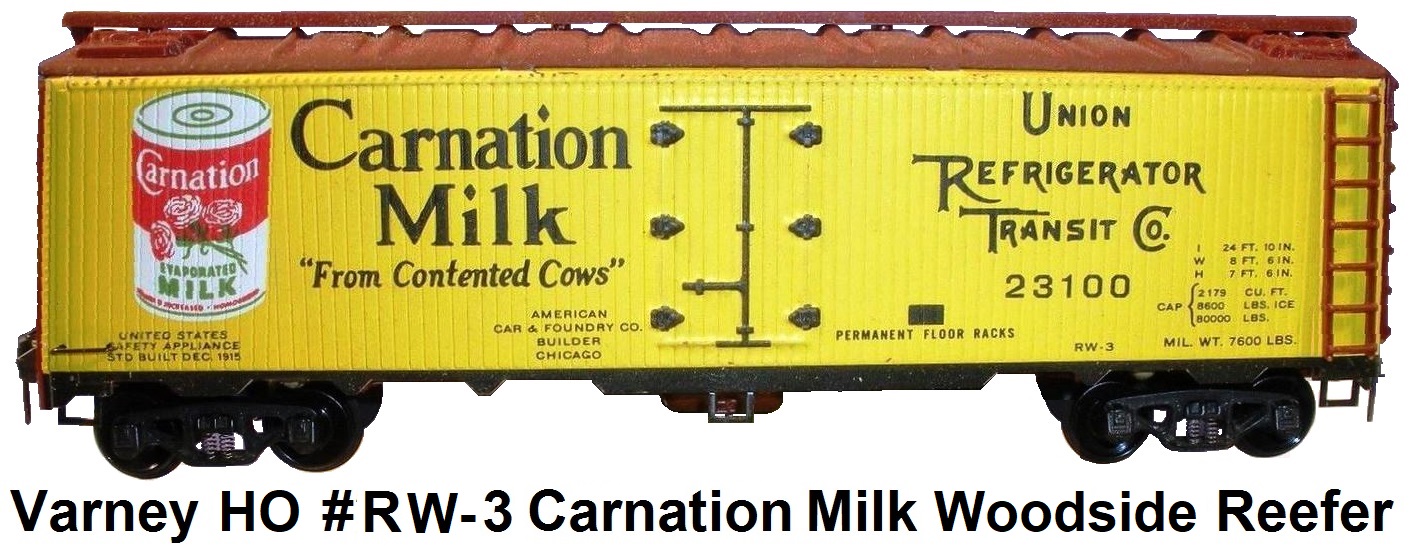
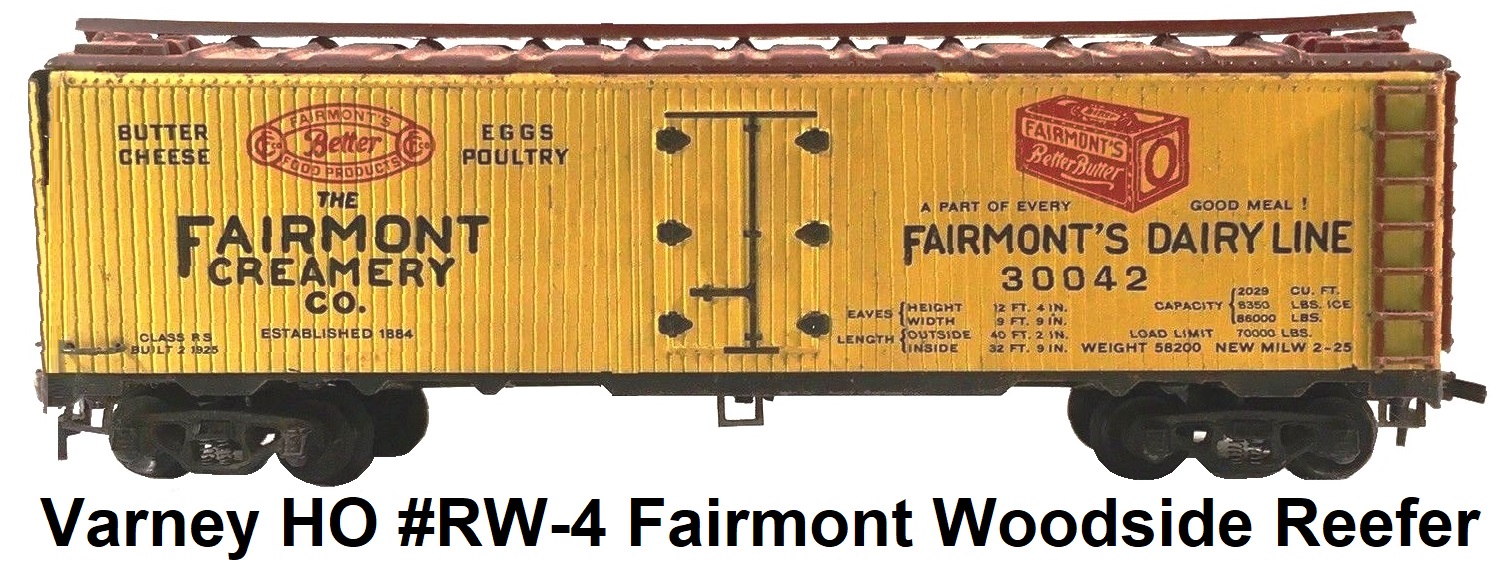
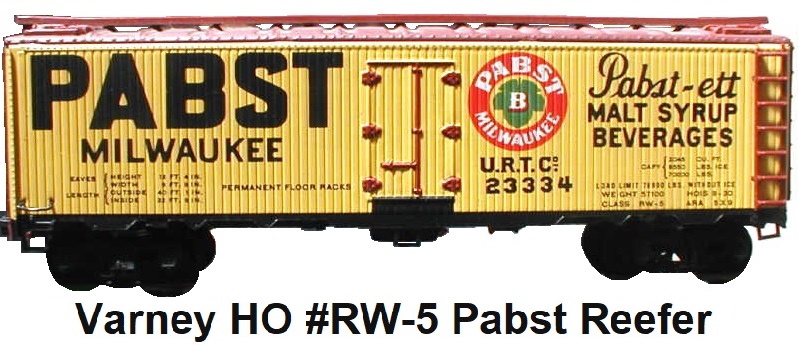

In the pre-war period, Varney offered an unusual HO scale electric outline GG-1-type streamlined locomotive
kit for 2 or 3-rail. It utilized their frame and motor mechanism from the 2-8-0 Consolidation, cut to fit. 4-wheel trailing
and leading trucks were attached to the frame, making this a 4-8-4. The body casting was aluminum that could be polished or
painted. While not to exact scale, it retained the body styling and flowing lines of the prototype, while meeting the model
railroad operating parameters of limited space. Many collectors believe that because this wheel configuration was not correct
for a GG-1 that Varney was actually attempting to model the PRR R1 prototype, which was a 4-8-4. The Pennsylvania Railroad's
class R1 comprised a single prototype electric locomotive constructed in 1934 by the Baldwin Locomotive Works of Philadelphia,
Pennsylvania, USA, with the electrical equipment by Westinghouse. It was built as a competitor to the GG-1 design, but after
trials the GG-1 was selected for volume production on the basis of its superior tracking and riding qualities; the R1
prototype, however, remained in service. For many years, the R1's regular duties involved hauling the westbound Broadway
Limited and returning eastward with a mail and express train. The Varney 1939 catalog clearly mentions that its model is a
'Streamline 4-8-4'. And that, "its design is adapted from the Pennsylvania GG-1." Kit price was $22.
 On December 17, 1940 Gordon Varney filed an application with the United States Patent office (US2284998A)
for a model railway truck that he designed. In the application he explained that it was an object of his invention to provide
a model railway truck which could be easily assembled by anyone, with perfect assurance that the assembled truck would be
square and accurate, so that it would rest properly on the rails. Up until this time in the model railway hobby the bolster
and the end plates of a truck were typically separate parts. The use of several separate parts was necessary because the ends
of the axles, protruding beyond the wheels, were inserted in bearing sockets in these end plates, and this insertion could
not be made except when the bolster and end plates were in separate pieces. The axles were inserted in the sockets at the
time the bolster and end plates were put together. Varney's invention provided a unitary frame member representing the
bolster and end plates, that included grooves or slots in which the ends of the axles could be received, together with means
for retaining the axles in the slots after they had been inserted. Varney also found it advantageous to shape the ends of the
axles with a point, and to also shape the corresponding bearing slots that way so as to reduce friction. This design
facilitated keeping the axles retained in the slots, without the necessity of using additional parts, screws or rivets, and
as a result nothing would show on the outer surface of the end plates that would destroy the realism.
On December 17, 1940 Gordon Varney filed an application with the United States Patent office (US2284998A)
for a model railway truck that he designed. In the application he explained that it was an object of his invention to provide
a model railway truck which could be easily assembled by anyone, with perfect assurance that the assembled truck would be
square and accurate, so that it would rest properly on the rails. Up until this time in the model railway hobby the bolster
and the end plates of a truck were typically separate parts. The use of several separate parts was necessary because the ends
of the axles, protruding beyond the wheels, were inserted in bearing sockets in these end plates, and this insertion could
not be made except when the bolster and end plates were in separate pieces. The axles were inserted in the sockets at the
time the bolster and end plates were put together. Varney's invention provided a unitary frame member representing the
bolster and end plates, that included grooves or slots in which the ends of the axles could be received, together with means
for retaining the axles in the slots after they had been inserted. Varney also found it advantageous to shape the ends of the
axles with a point, and to also shape the corresponding bearing slots that way so as to reduce friction. This design
facilitated keeping the axles retained in the slots, without the necessity of using additional parts, screws or rivets, and
as a result nothing would show on the outer surface of the end plates that would destroy the realism.
Varney was one of the earliest manufacturers to use plastic and made their first plastic kit parts as early as 1940, using a
cellulose acetate plastic called 'Tenite'. Over the years Varney offered 50 ton hopppers, 10,000 gallon tank cars, gondolas,
stock cars and 40' outside braced wood box cars in HO that featured parts that were made using Tenite. Tenite was an
injection molded acetate most often used for tool handles and control knobs of all sorts. The use of injection molded
plastic eliminated the need to paint the car parts, as the natural color of the plastic could be mixed to any shade. Plastic
also provided excellent detail in the castings, devoid of flash. Varney kits with plastic car bodies still featured
a metal fish belly that gave the plastic cars a low center of gravity.
Varney 40' Outside Braced Wood Box Cars - Styrene Plastic Molded Built-up Kits & Ready-to-Run
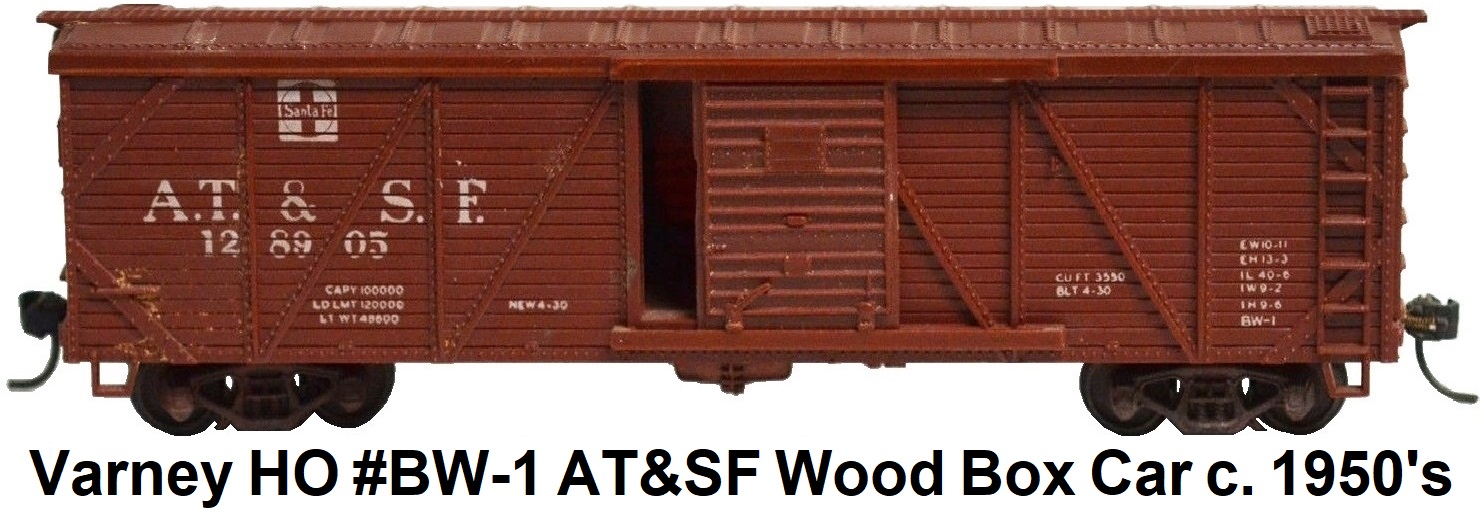
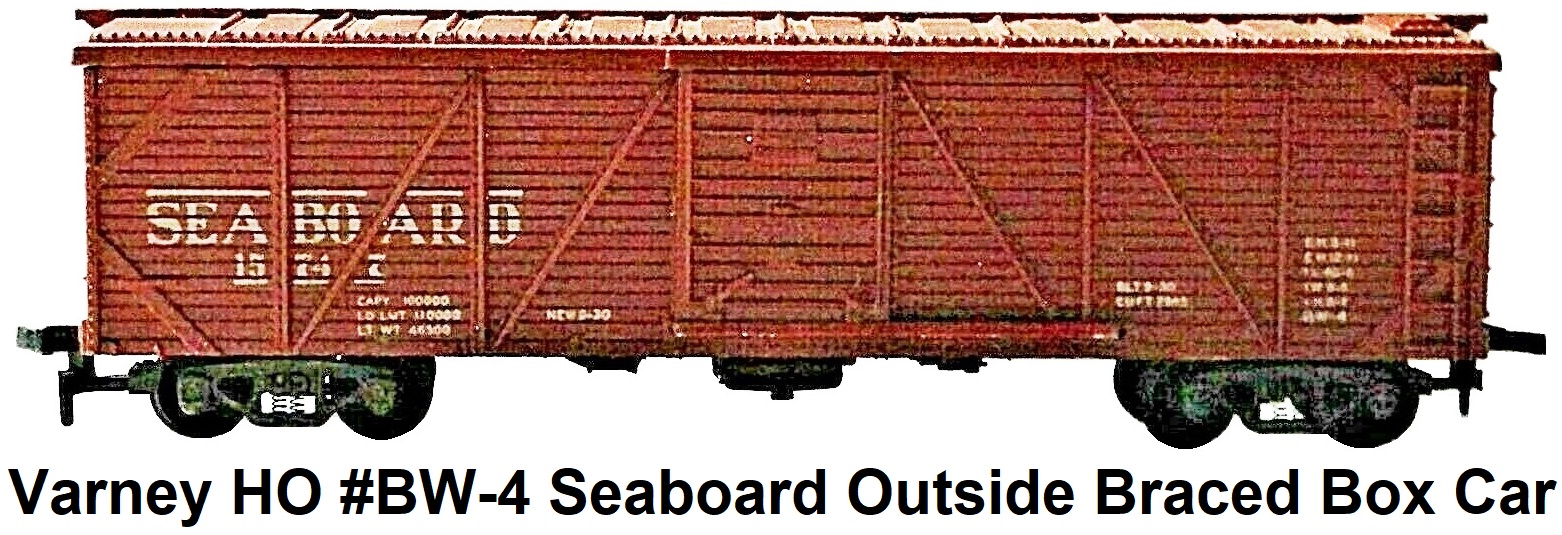
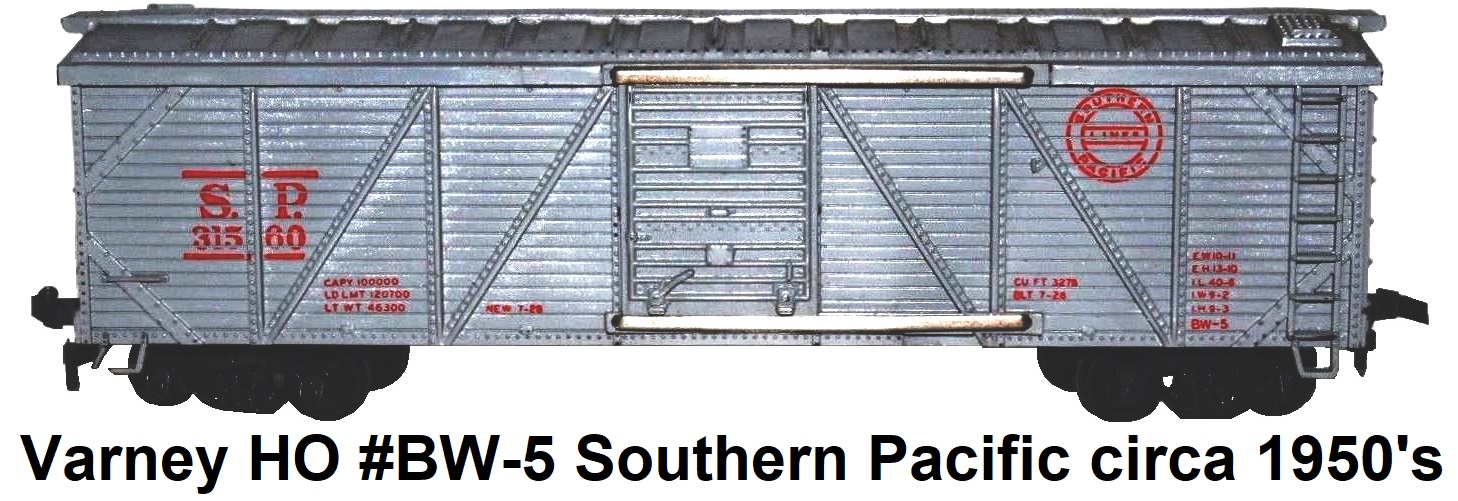
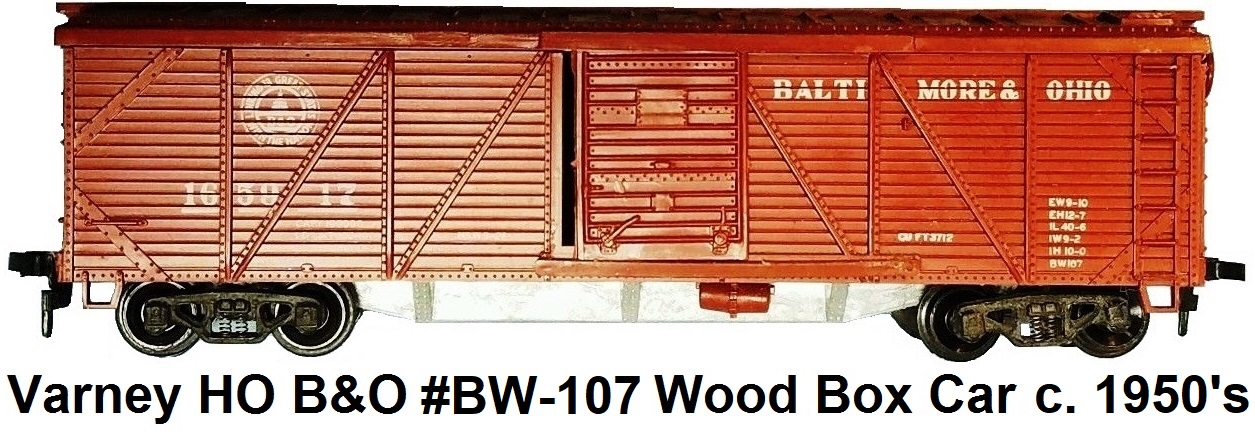

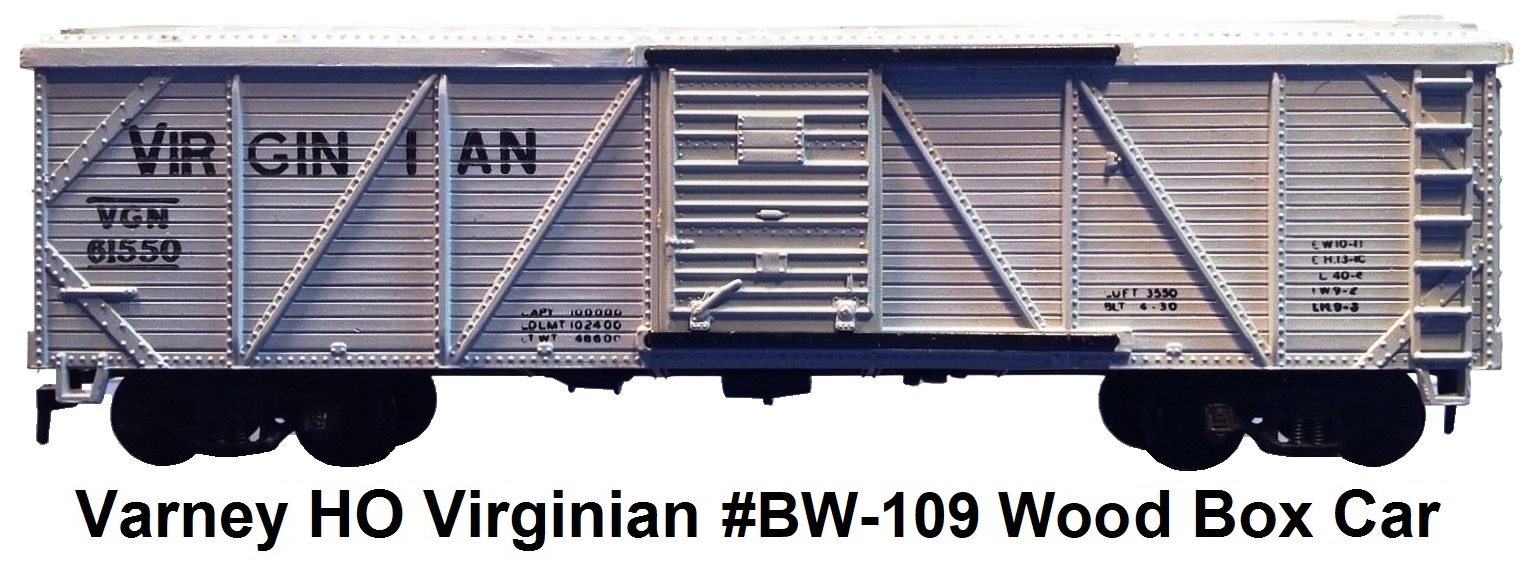
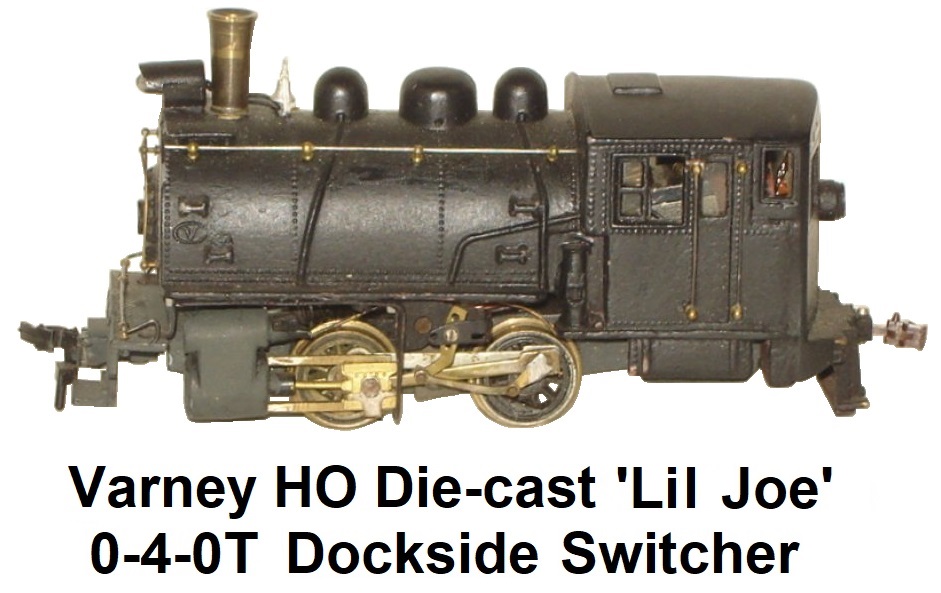 Varney began selling 5-pole armatures for the V-1 motor in 1940. This modification converted the motor to operate on 12-volts
DC. In 1941 Varney introduced their die-cast HO model of the Baltimore & Ohio 0-4-0 Dockside 'Lil Joe'
switcher tank steam locomotive. The Varney Dockside switcher is credited with greatly influencing the popularity of HO 1:87
scale during these formative years of the hobby.
Varney began selling 5-pole armatures for the V-1 motor in 1940. This modification converted the motor to operate on 12-volts
DC. In 1941 Varney introduced their die-cast HO model of the Baltimore & Ohio 0-4-0 Dockside 'Lil Joe'
switcher tank steam locomotive. The Varney Dockside switcher is credited with greatly influencing the popularity of HO 1:87
scale during these formative years of the hobby.
During the war, production of model trains ceased while the shop produced military parts, primarily screws.
After the war, Varney resumed production with updated versions of many of the pre-war model train kits.
Varney, along with Mantua Metal Products, was one of the premier
manufacturers of HO gauge trains in the period between 1945 and 1955, offering an extensive
line of locomotives and rolling stock. Varney's first postwar locomotive was a die-cast version
of the pre-war Baltimore and Ohio RR 'Lil Joe' Class C-16 0-4-0 tank Dockside switcher. It was a very popular seller
and featured a Pittman DC-60 motor, and could be detailed using a valve gear kit from Central
Valley Mfg. It sold for $15.
Other Varney steam locomotives of this era included a Reading RR-based heavy 2-8-0
Consolidation, a Southern Pacific-based P-7 Pacific 4-6-2, a freelance 4-6-4 Hudson, a freelance
streamlined Pacific and Hudson, a freelance 4-8-4 Northern, a Southern Pacific-based 2-8-2 Mikado,
a freelance 2-8-2 Mikado and a very similar 2-8-4 Berkshire utilizing the same superstructure casting.
The streamlined Pacific and Hudson was offered with a bronze boiler, the only difference between the 2 locos
being the trailing truck.
 Varney also offered a bronze or aluminum superstructure casting for its 2-8-8-4 Yellowstone articulated,
which when combined with appropriate Varney parts, made an impressive model. A Southern Pacific 4-6-0 shared the same boiler
and cab as the 2-8-0 Consolidation. The 4-6-4 Hudson used the same bronze boiler as the Mikado. The tenders for all of
these locomotives were sold separately. Choices included a Vanderbilt tender with 6-wheel trucks,
two long-distance style coal tenders, a wood and cardstock tender for the streamlined Hudson/Pacific,
and a die cast slope back tender that could be used with the Dockside Switcher. While several Varney locos are
considered to be freelance models, it is believed that since Varney originated in the Chicago area that many were
loosely based after prototypes from railroads that serviced that part of the country. The Varney 2-8-4 Berkshire is possibly
modeled from the Chicago & NorthWestern J-4A and the Varney Northern could most likely be patterned after the Grand Trunk
Western U-3-b. The 1947-48 Varney price list indicates that a #1913-K-4 rigid frame Pacific kit could be
purchased for $27.50. The Economy Pacific 4-6-2 kit was $37.50 (without tender). The Super Mikado 2-8-2 was $58.50
(less tender).
Varney also offered a bronze or aluminum superstructure casting for its 2-8-8-4 Yellowstone articulated,
which when combined with appropriate Varney parts, made an impressive model. A Southern Pacific 4-6-0 shared the same boiler
and cab as the 2-8-0 Consolidation. The 4-6-4 Hudson used the same bronze boiler as the Mikado. The tenders for all of
these locomotives were sold separately. Choices included a Vanderbilt tender with 6-wheel trucks,
two long-distance style coal tenders, a wood and cardstock tender for the streamlined Hudson/Pacific,
and a die cast slope back tender that could be used with the Dockside Switcher. While several Varney locos are
considered to be freelance models, it is believed that since Varney originated in the Chicago area that many were
loosely based after prototypes from railroads that serviced that part of the country. The Varney 2-8-4 Berkshire is possibly
modeled from the Chicago & NorthWestern J-4A and the Varney Northern could most likely be patterned after the Grand Trunk
Western U-3-b. The 1947-48 Varney price list indicates that a #1913-K-4 rigid frame Pacific kit could be
purchased for $27.50. The Economy Pacific 4-6-2 kit was $37.50 (without tender). The Super Mikado 2-8-2 was $58.50
(less tender).

In 1947 Varney came out with its V-2 12-volt DC Super motor. It featured an enclosed brush holder,
Alnico permanent magnet and worm gear support. This motor had a 7-pole armature with ball bearing supports on the worm shaft.
The Varney Consolidation, Pacific and Mikado were offered in economy versions that were equipped with a
Pittman DC-71 motor, one piece brass frame, and non-sprung drive wheels, or in a Super version that featured the
new Lindsay-designed V-2 7-pole ball bearing motor, 2-piece brass frame, sprung drive wheels and a more detailed valve
gear.
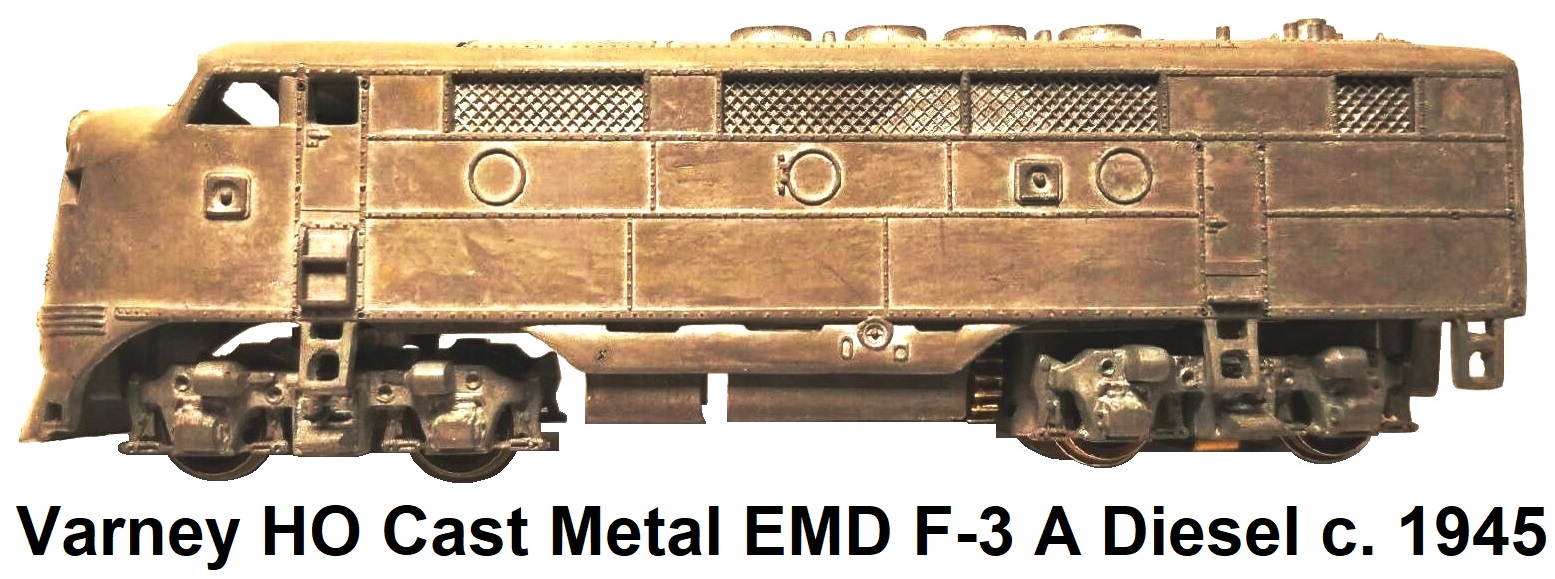 Between 1945 and 1949 Varney produced an HO cast metal F-3 EMD diesel locomotive in two versions. One with 2 power trucks,
and one with a single power truck. The loco utilized zinc pressure die-cast parts and featured a high level of detail,
including louvered ventilator fan housings on the roof, windshield wipers on the window screens, fuel tank filler caps,
visible structual bracing, portholes, number boards, nose grabs, diesel air horns, ladders and doors. The F-3 was also offered
in a non-powered dummy unit using the same body castings. B units were also offered, in both powered and unpowered
versions. The F-3 was driven by a Pittman 5-pole DC-60 motor. Varney fitted these models with scale diesel truck frames,
and gave the modeler the option of either 40" or 36" scale wheels for the dummy units. $19.75 was the cost for either an
F-3 A or B powered unit kit, and dummy units were $7.50.
Between 1945 and 1949 Varney produced an HO cast metal F-3 EMD diesel locomotive in two versions. One with 2 power trucks,
and one with a single power truck. The loco utilized zinc pressure die-cast parts and featured a high level of detail,
including louvered ventilator fan housings on the roof, windshield wipers on the window screens, fuel tank filler caps,
visible structual bracing, portholes, number boards, nose grabs, diesel air horns, ladders and doors. The F-3 was also offered
in a non-powered dummy unit using the same body castings. B units were also offered, in both powered and unpowered
versions. The F-3 was driven by a Pittman 5-pole DC-60 motor. Varney fitted these models with scale diesel truck frames,
and gave the modeler the option of either 40" or 36" scale wheels for the dummy units. $19.75 was the cost for either an
F-3 A or B powered unit kit, and dummy units were $7.50.
Apart from locomotives and carriages Varney also made a series of HO-scale car and truck models, primarily
Fords. The vehicles were solid and had no interiors. Some were made of clear plastic, to encourage hobbyists to paint the
vehicles, but leave the windows unpainted. The models had black wheels and were sold both as ready-made painted models and
as kits. There was also a brief endeavor to make and market ship and airplane kits. In 1944 Varney produced a wood, cardstock
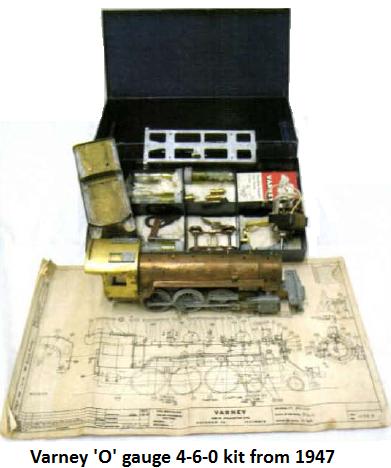 and metal PT boat kit that featured detail parts cast in Tenite. At the end of the war, Varney introduced an LST model in the
same mixed materials. In 1946 Varney followed these with a U.S. Fleet Submarine and Stearman PT-17 trainer both made entirely
of Tenite. Since Tenite can be used to create very thick, solid parts, the hull of the sub and fuselage of the PT-17 were
single solid pieces of plastic. But sales of these products were poor, and Varney wound up selling the molds to O-Lin.
and metal PT boat kit that featured detail parts cast in Tenite. At the end of the war, Varney introduced an LST model in the
same mixed materials. In 1946 Varney followed these with a U.S. Fleet Submarine and Stearman PT-17 trainer both made entirely
of Tenite. Since Tenite can be used to create very thick, solid parts, the hull of the sub and fuselage of the PT-17 were
single solid pieces of plastic. But sales of these products were poor, and Varney wound up selling the molds to O-Lin.
In 1947 Gordon Varney ventured into the 'O' scale (¼" to the foot) train market with the release of an 'O' scale
4-6-0 steam loco in kit form under the Varney name. The catalog stated that it was based on the Baltimore & Ohio RR
10-wheeler. Varney also offered 'O' scale 6-wheel passenger trucks and two kinds of freight trucks. Although considered
ground breaking, the loco did not sell very well. This tooling was later purchased by
General Models Corp. of Wheaton, IL, who enhanced the dies and created several other locomotive
castings from that tooling, including a 4-4-2 Atlantic, 4-6-2 Pacific, 4-8-2
Mountain and a 2-6-6-4 articulated. When GMC went bankrupt the tooling was subsequently acquired by
All-Nation Hobbies of Chicago in 1950. This
steam locomotive line was later sold to George Sennhauser of Babbit MN, who renamed the brand and added a 4-8-2 to the
catalog. Bryce Yates acquired the company in 1993 and expanded it to a selection of 6 locomotives. Eventually, Bill Wade
took over this line and operates his company B.T.S. in Belington, VA.
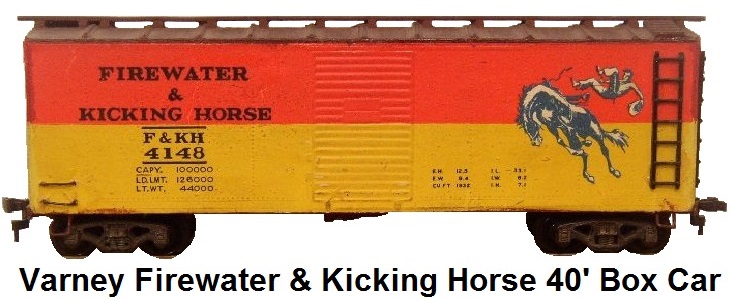 In June of 1948, Varney issued the Hollywood & Western refrigerator car after deciding
that there was a market for private owner car models. The H&W was a refrigerator car from a famous pioneering model railroad
layout belonging to Jim Trout, Sam Raymond, and Dick Sutphen. Varney came up with the name and made the sides for the reefer
car when he visited the layout at Trout's home prior to World War II. Those car kits, along with the Firewater & Kicking Horse
box car were the first recorded mass-produced private owner cars ever made available to the public in HO scale.
Bob Lindsay, who was mentioned earlier as a locomotive designer for Varney, began his own business in 1948.
He initially produced Lindsay motors and power trucks under the name of Lindsay Products, based in Culver City, CA. He also
produced power unit mounting kits, HO and TT scale couplers, and HO die-cast metal Alco passenger and road diesel locomotives
under the Quality Line brand name. In 1950 he added an HO EMD 1000 HP diesel cast from solid brass, an HO 0-4-0 Stubby yard
diesel switcher cast from Zamac and a Tiny Tim 0-4-0 Dockside Tank switcher in TT scale. The Lindsay line was acquired by
Kemtron in 1955.
In June of 1948, Varney issued the Hollywood & Western refrigerator car after deciding
that there was a market for private owner car models. The H&W was a refrigerator car from a famous pioneering model railroad
layout belonging to Jim Trout, Sam Raymond, and Dick Sutphen. Varney came up with the name and made the sides for the reefer
car when he visited the layout at Trout's home prior to World War II. Those car kits, along with the Firewater & Kicking Horse
box car were the first recorded mass-produced private owner cars ever made available to the public in HO scale.
Bob Lindsay, who was mentioned earlier as a locomotive designer for Varney, began his own business in 1948.
He initially produced Lindsay motors and power trucks under the name of Lindsay Products, based in Culver City, CA. He also
produced power unit mounting kits, HO and TT scale couplers, and HO die-cast metal Alco passenger and road diesel locomotives
under the Quality Line brand name. In 1950 he added an HO EMD 1000 HP diesel cast from solid brass, an HO 0-4-0 Stubby yard
diesel switcher cast from Zamac and a Tiny Tim 0-4-0 Dockside Tank switcher in TT scale. The Lindsay line was acquired by
Kemtron in 1955.
Varney HO 40' Steel Reefers from Metal Kits

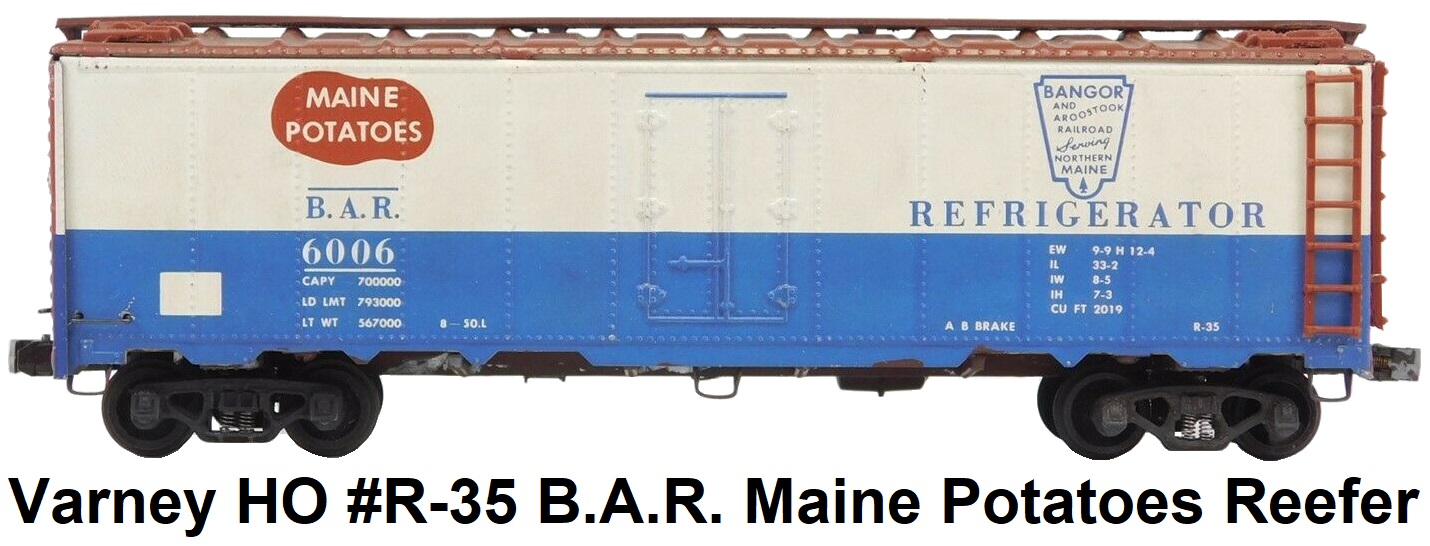

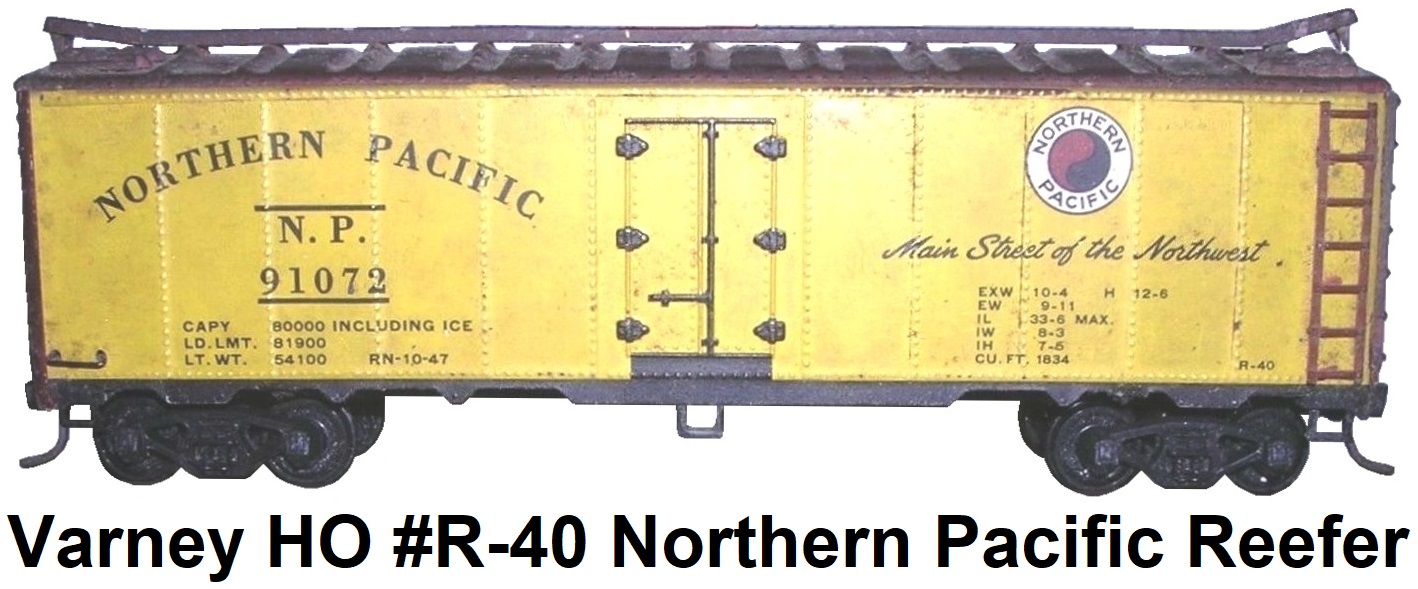
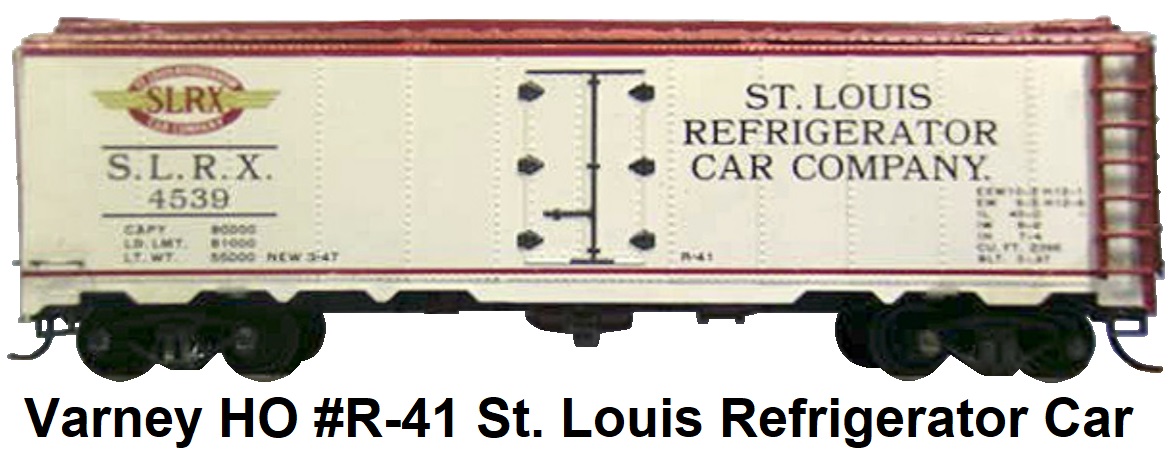
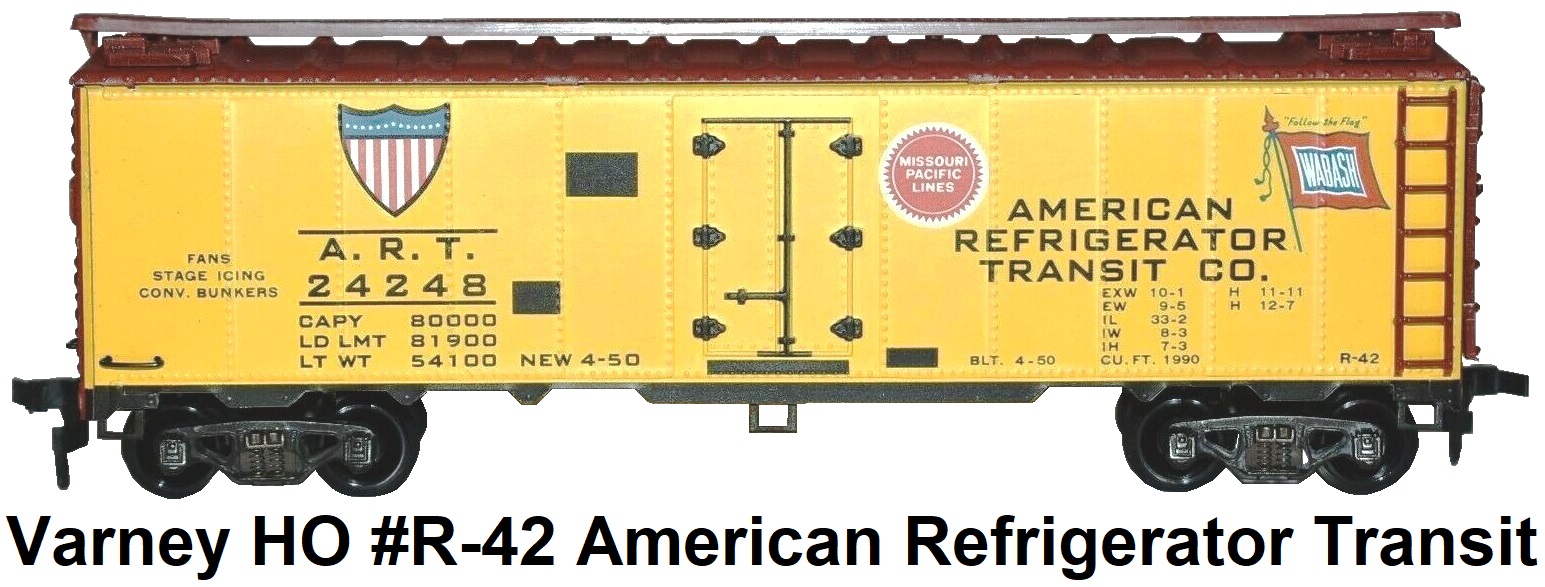
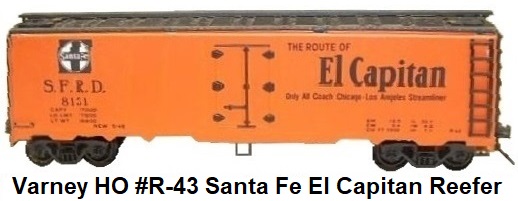
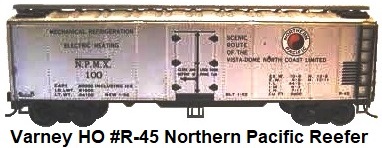
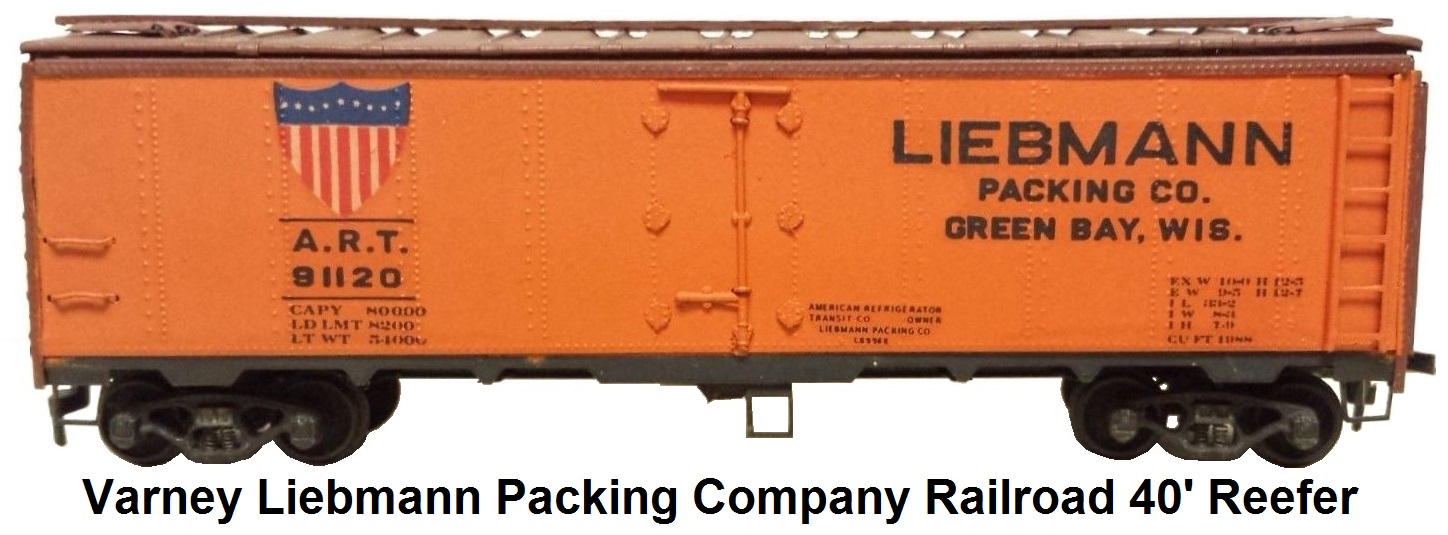
The stamped steel version of the Varney HO 40' box car kit was introduced in 1949. The box car floors were
wood, but everything else was metal. The cars were prepainted with baked enamel and the lettering was lithograph screen
printed. The box cars featured sprung metal trucks and an operating detailed sliding door. The 1-piece pre-formed roof
included ribs. The underframe was die-cast. Complete kits were sold for $3.00.
Varney 40' AAR Steel Box Cars Built from Metal Embossed Kits, Pre-1955 issue
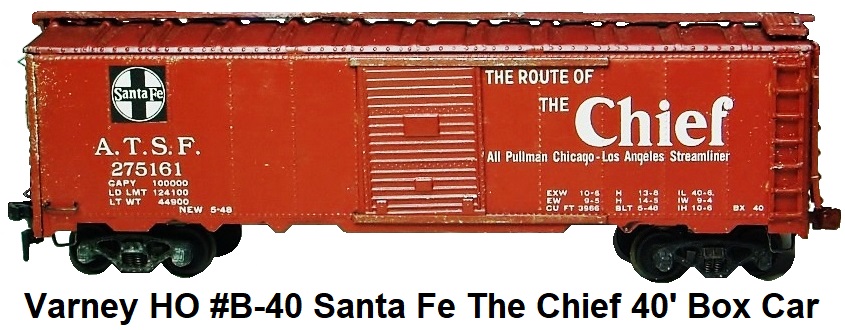
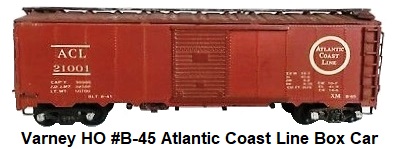
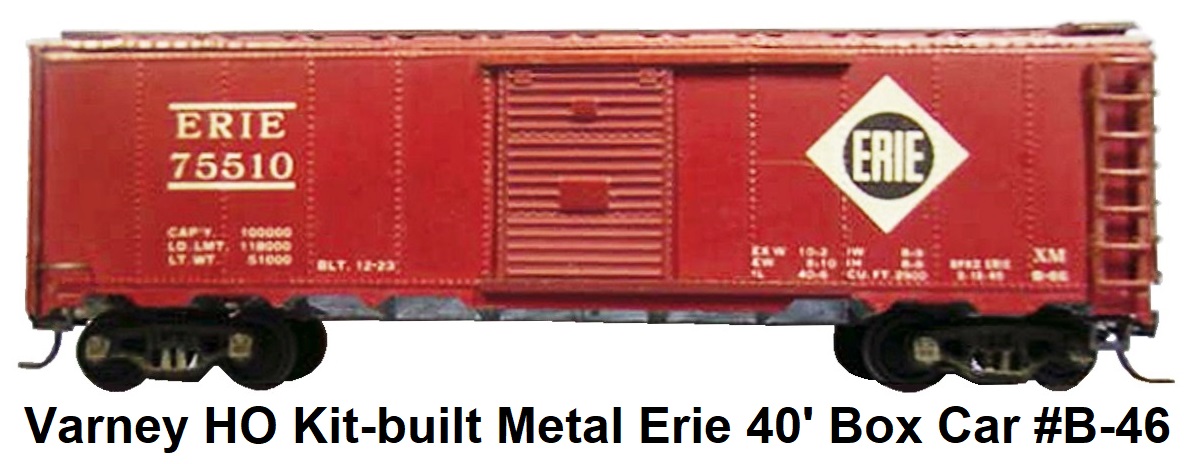
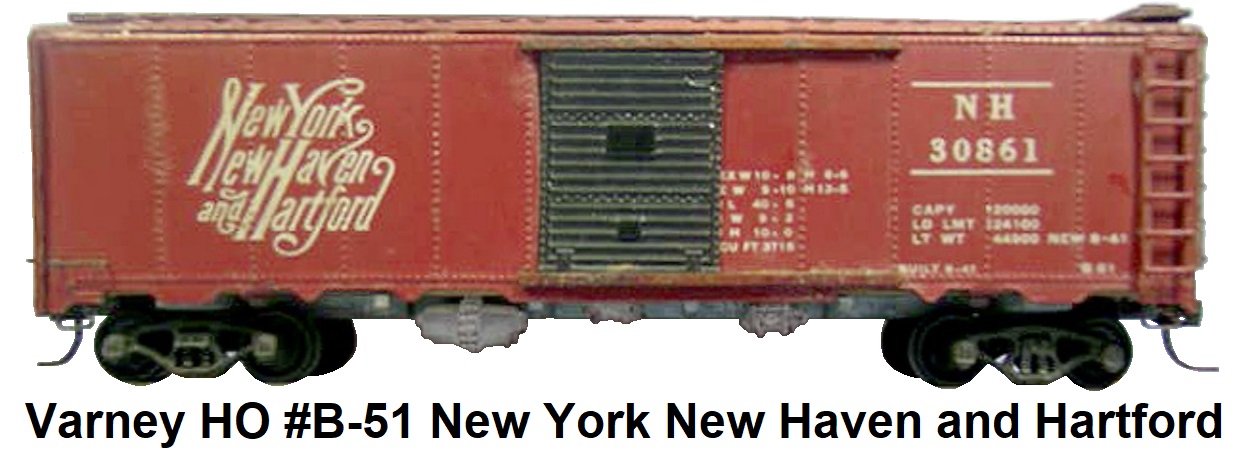
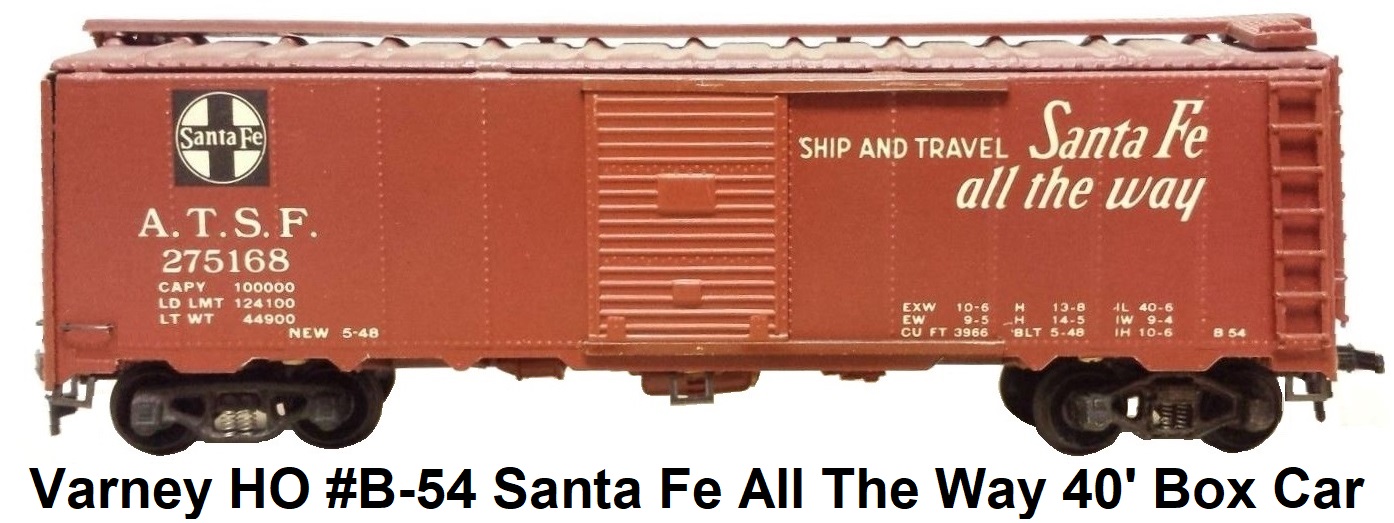
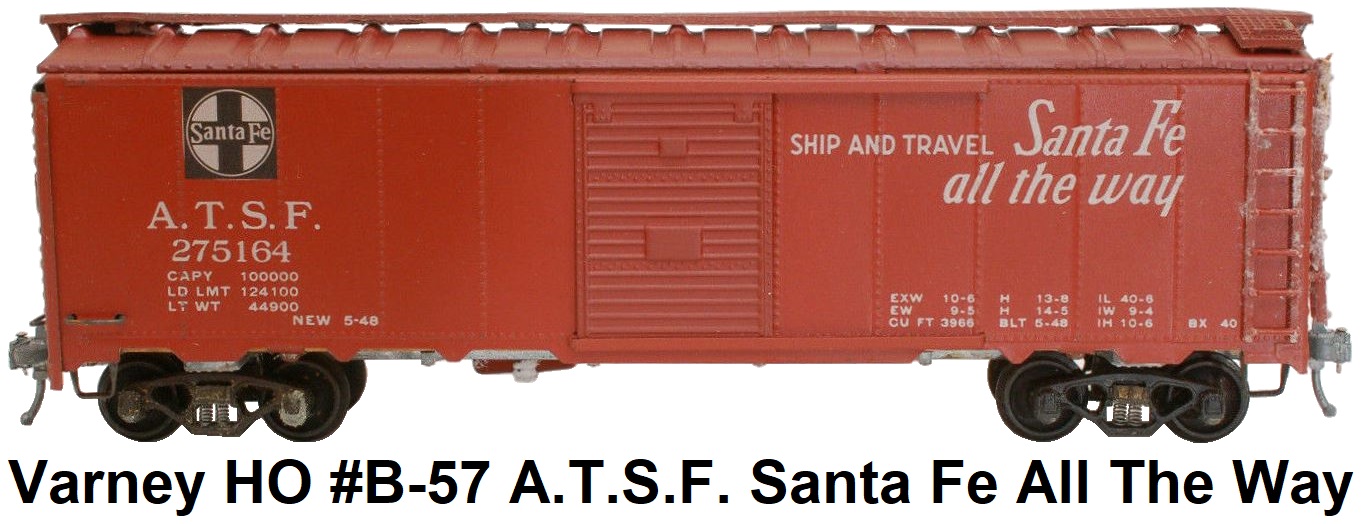
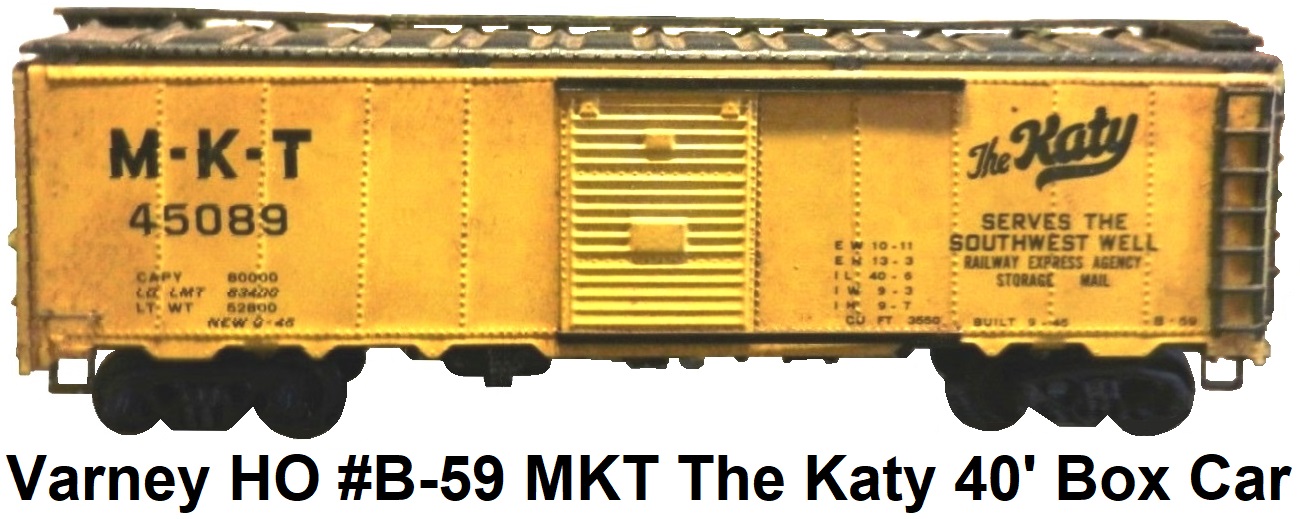
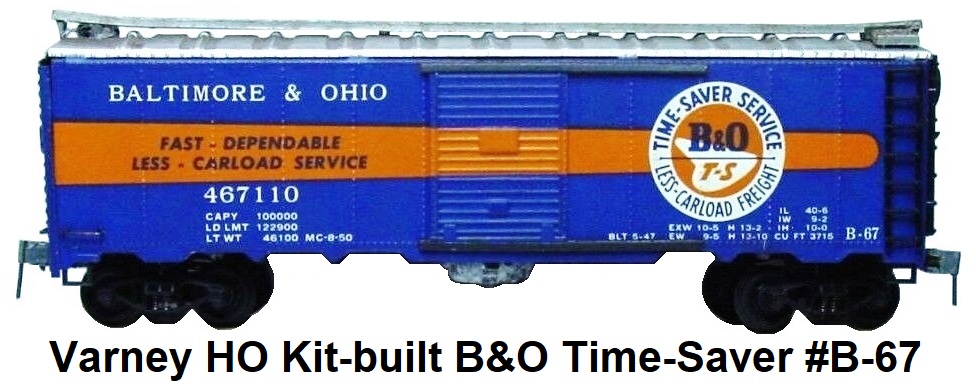
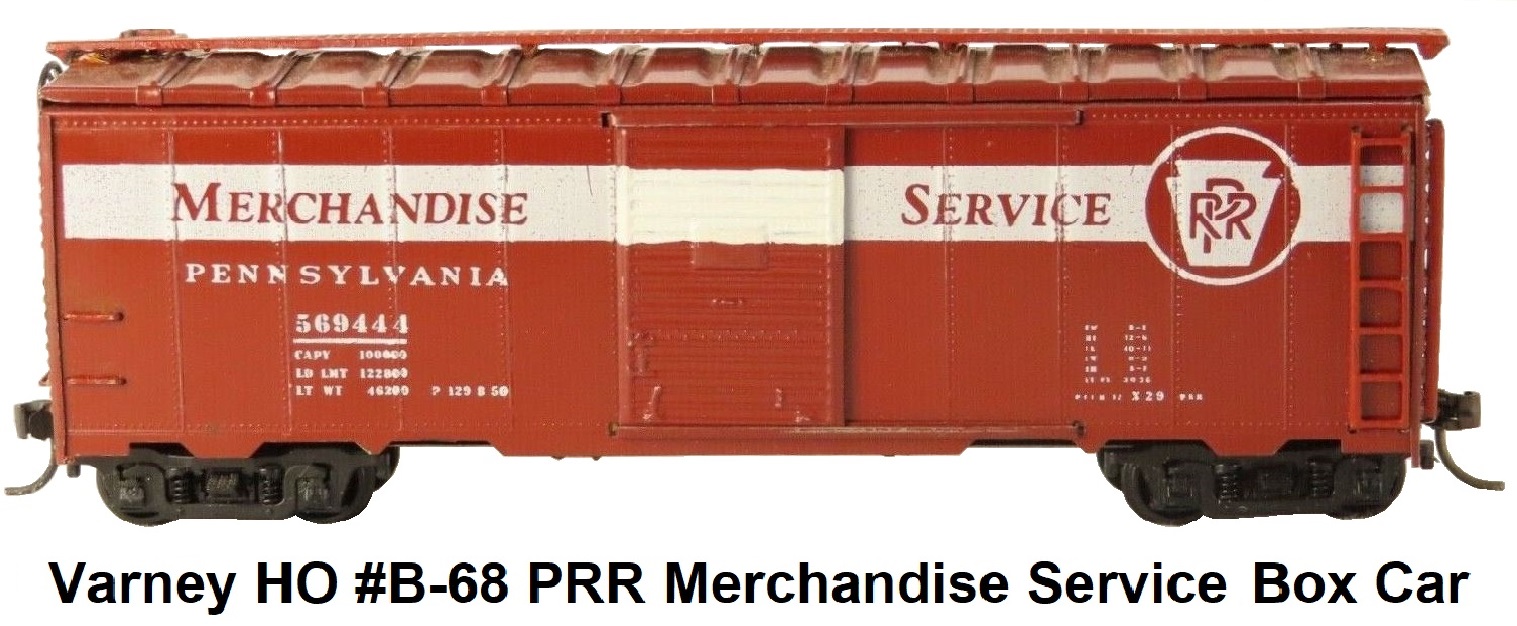

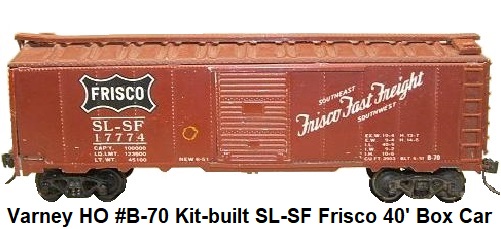
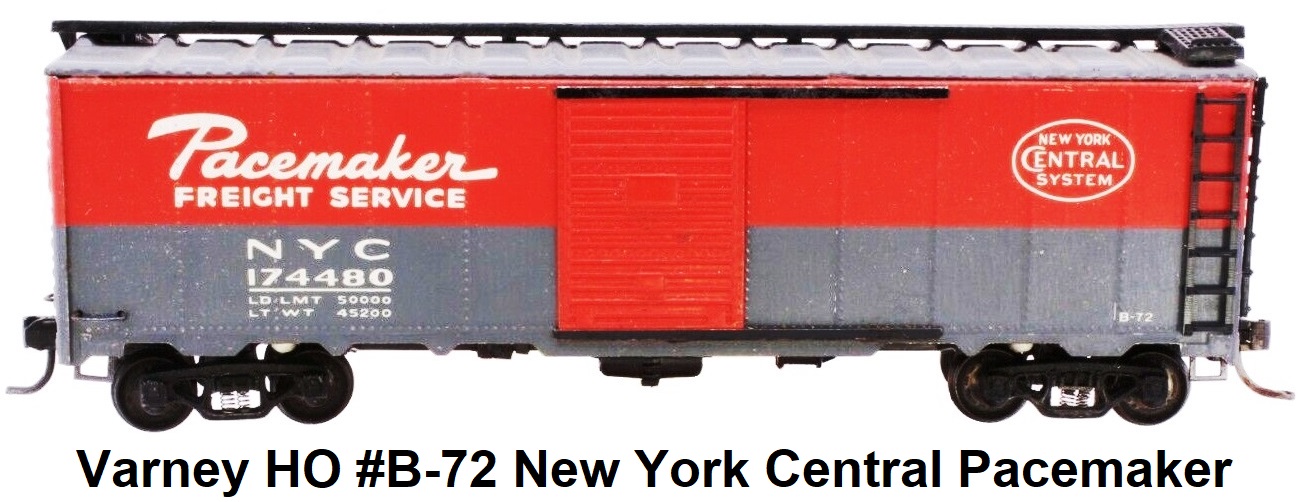

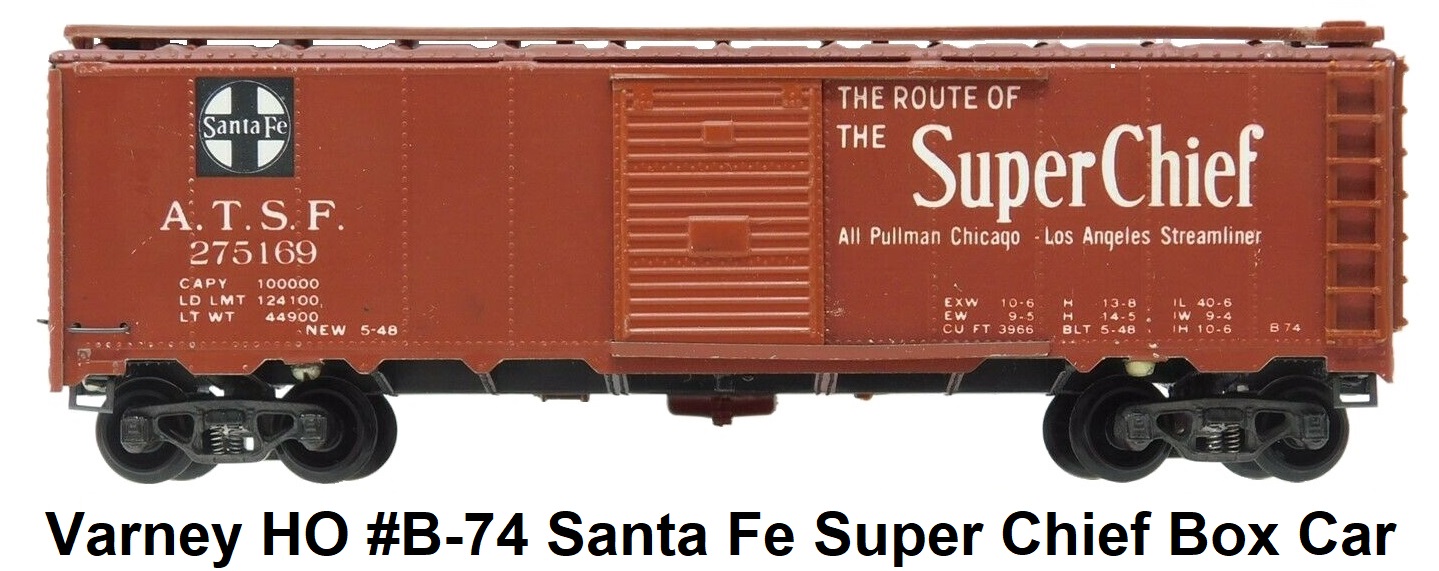

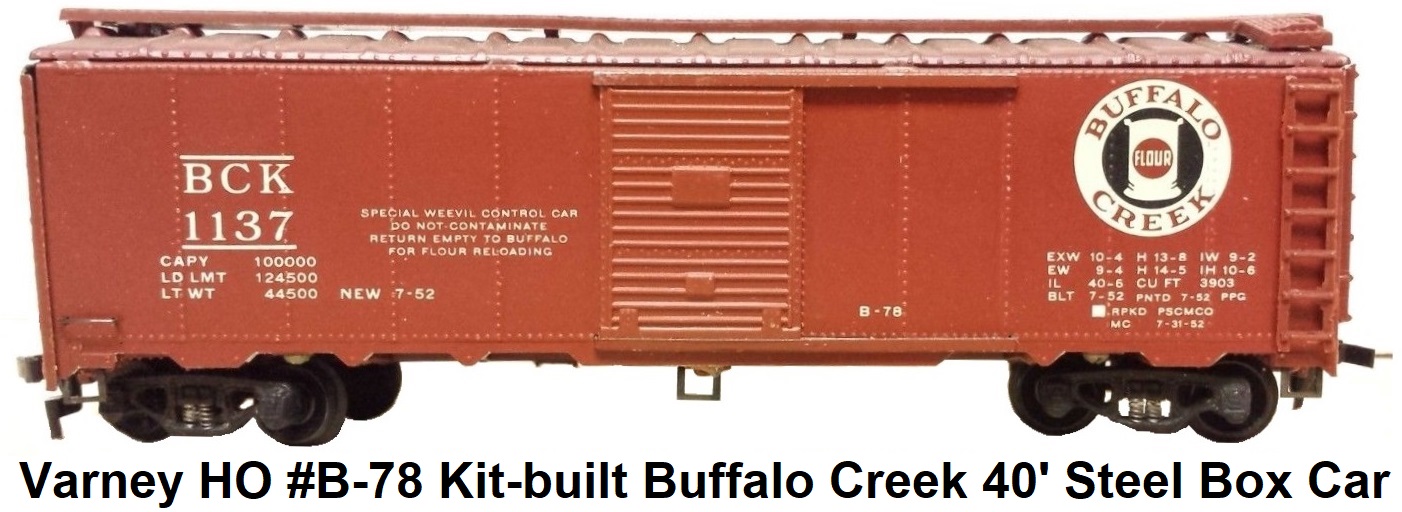

In 1948 Varney introduced a new V-3 12-volt DC enclosed Super motor similar to the V-2 with the difference
being that it had an exposed straight shaft with a different shaft support casting where the ball bearing was visible at the
position it was mounted in the shaft support. This motor could be adapted to fit into any pre-war locomotive frames by filing
away some casting supports. Any gear could be mounted onto the ⅛" shaft. The V-3 ran at .2 to .7 amps and put out
10,000 to 16,000 RPM. The same year, a V-4 Direct drive 7-pole 12-volt DC motor was issued that was designed specifically for
the Varney F-3 diesel locomotives. This direct drive motor was very similar to the V-2 and V-3 motors but had a very short
motor shaft adapter casting and included double threaded worms mounted on the motor shaft and gears with a 13 to 1 gear
ratio.
Varney Tank Cars From Plastic Injection Molded Kits
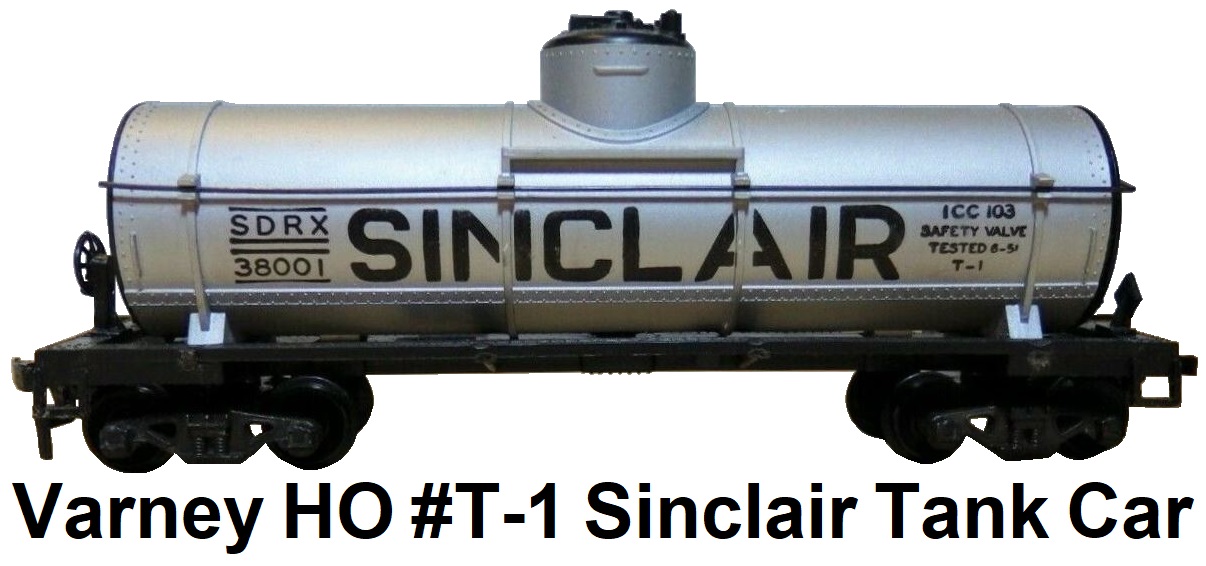
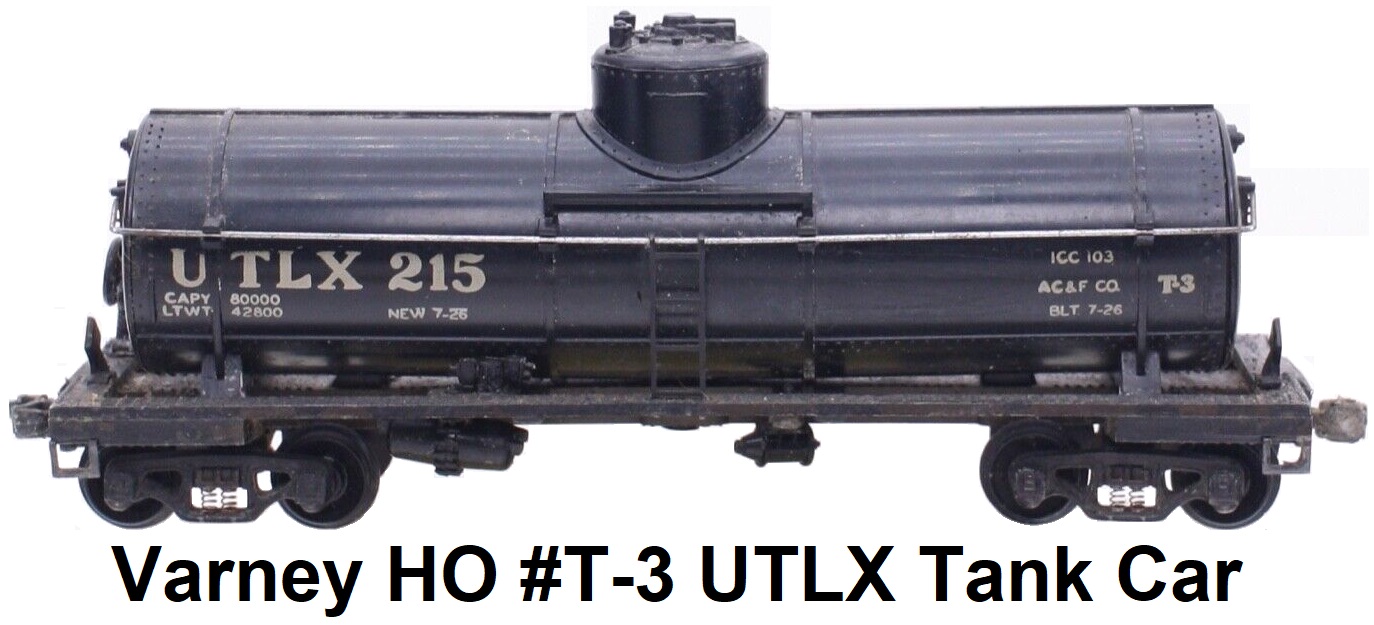
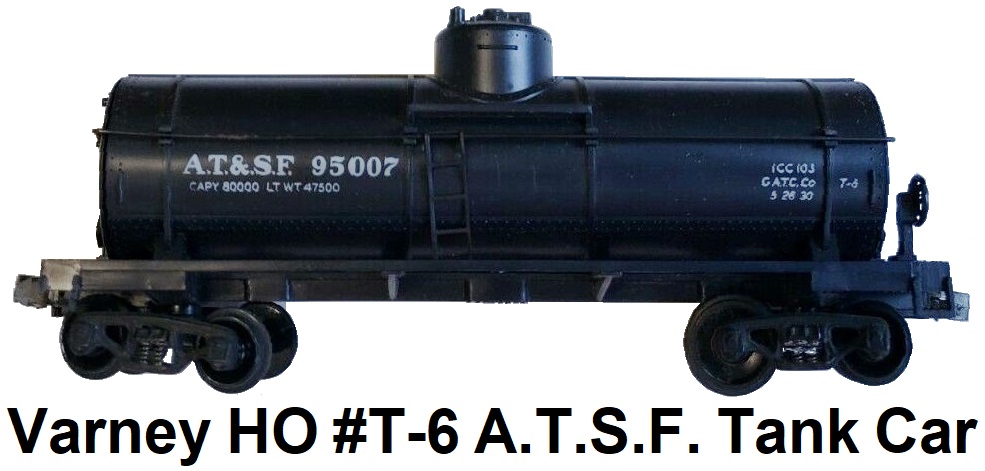
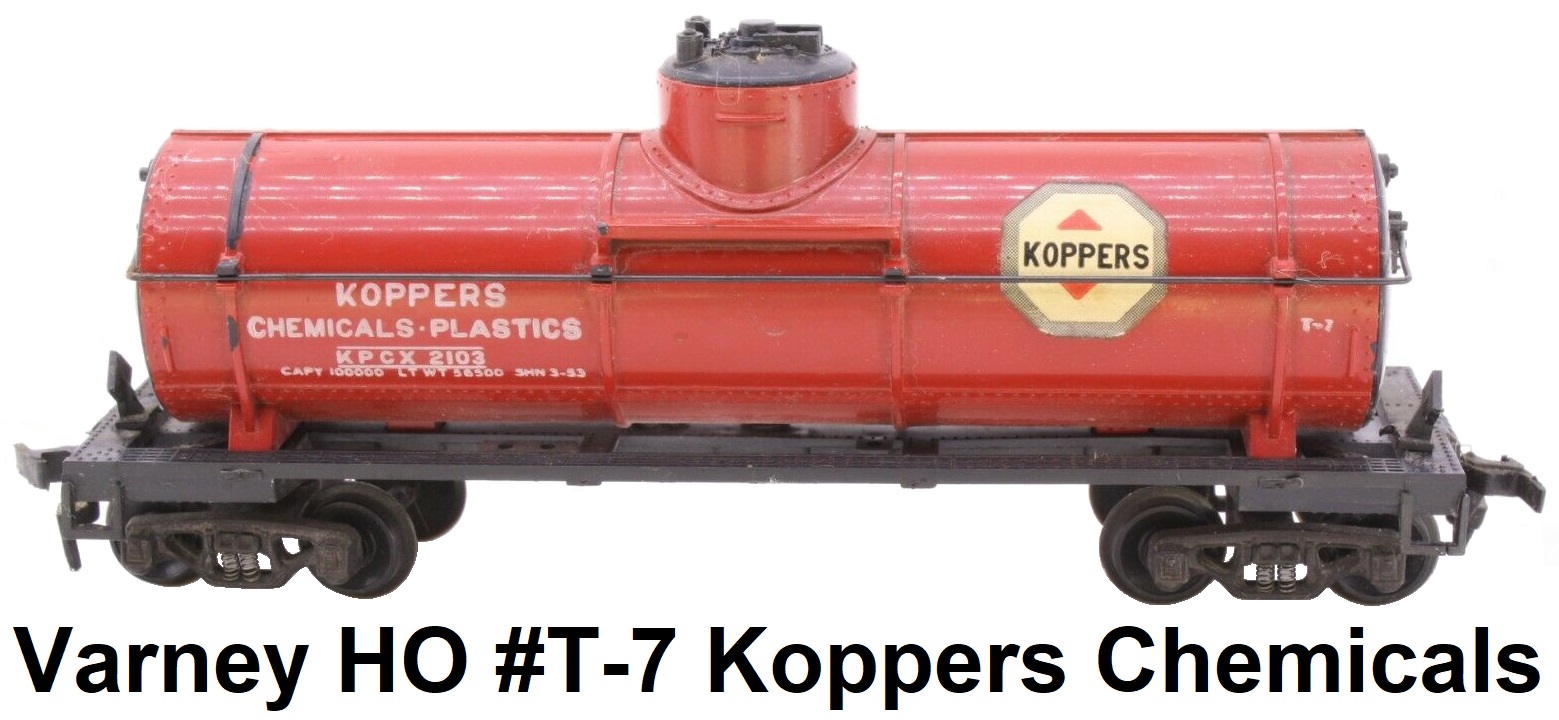
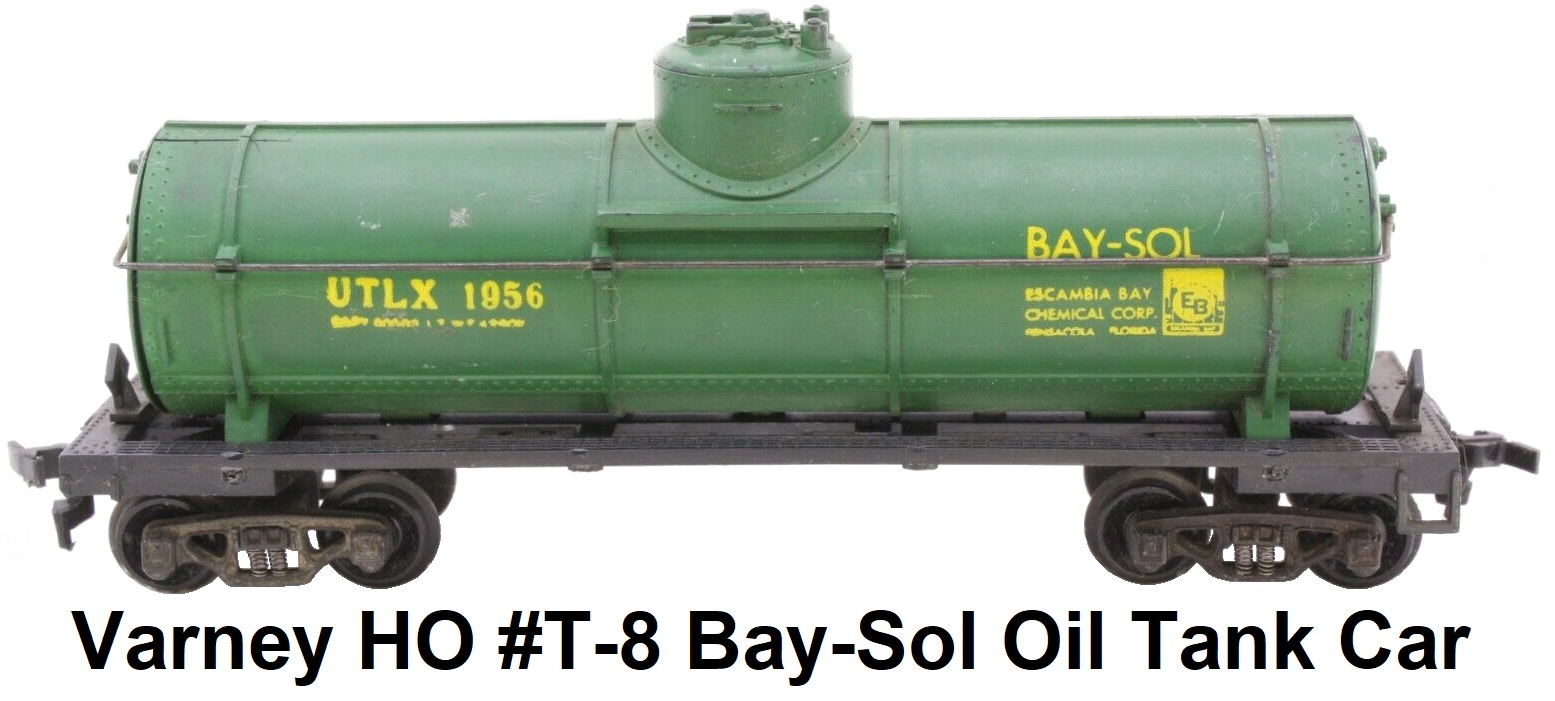
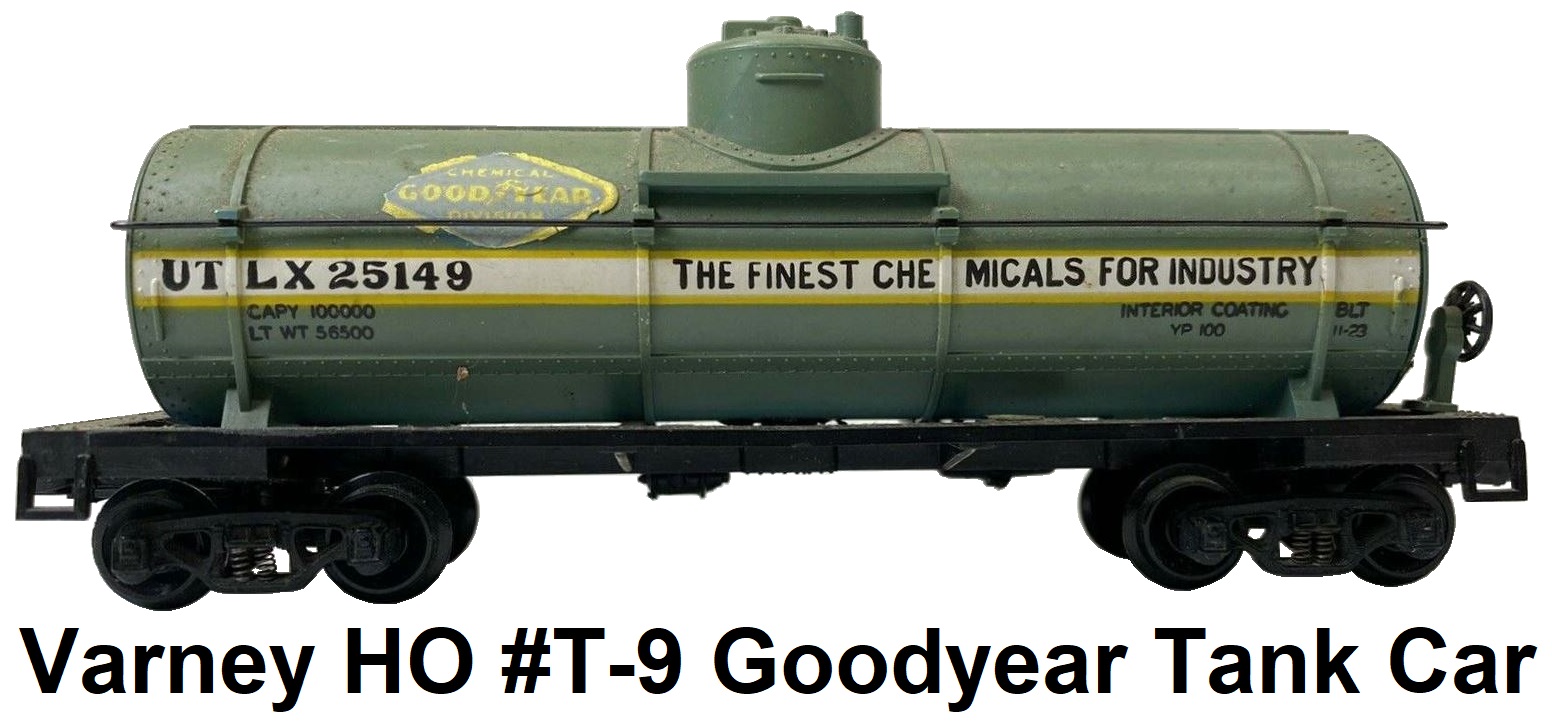
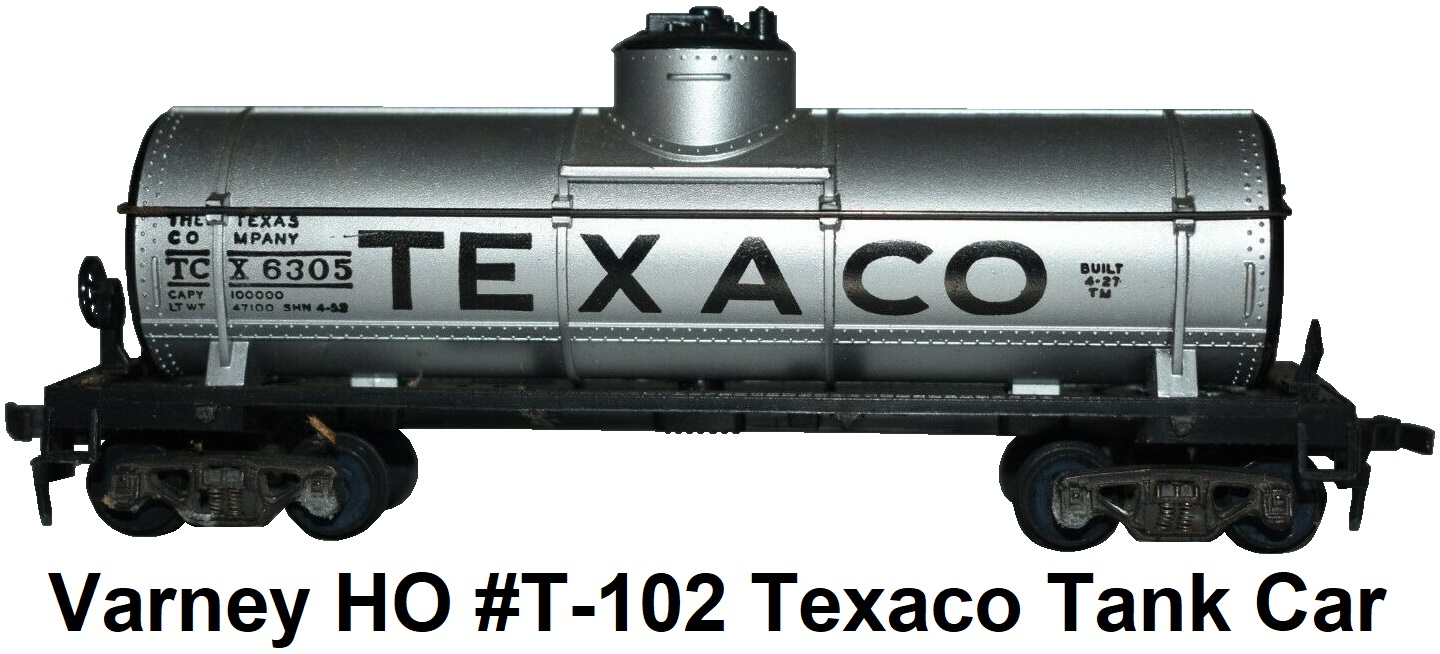
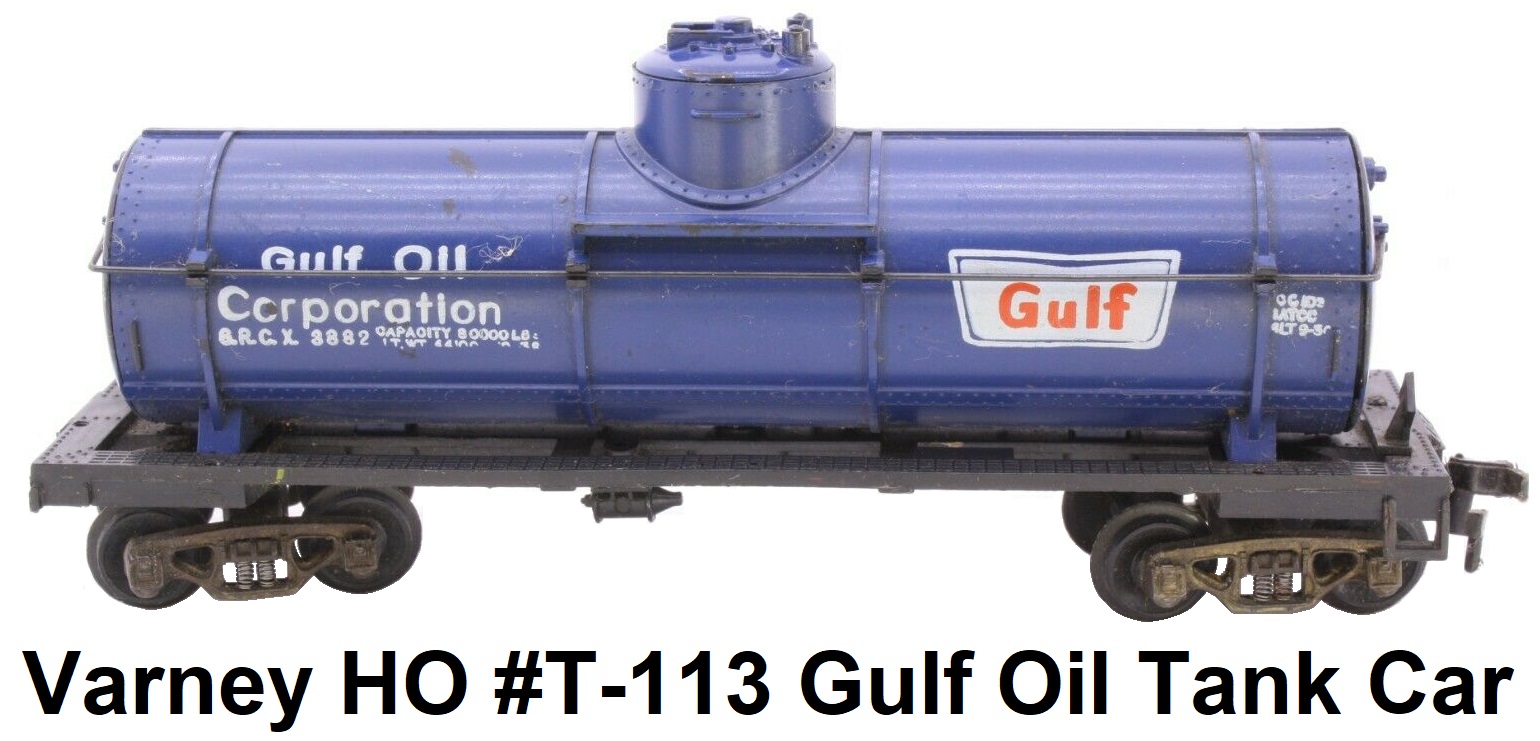
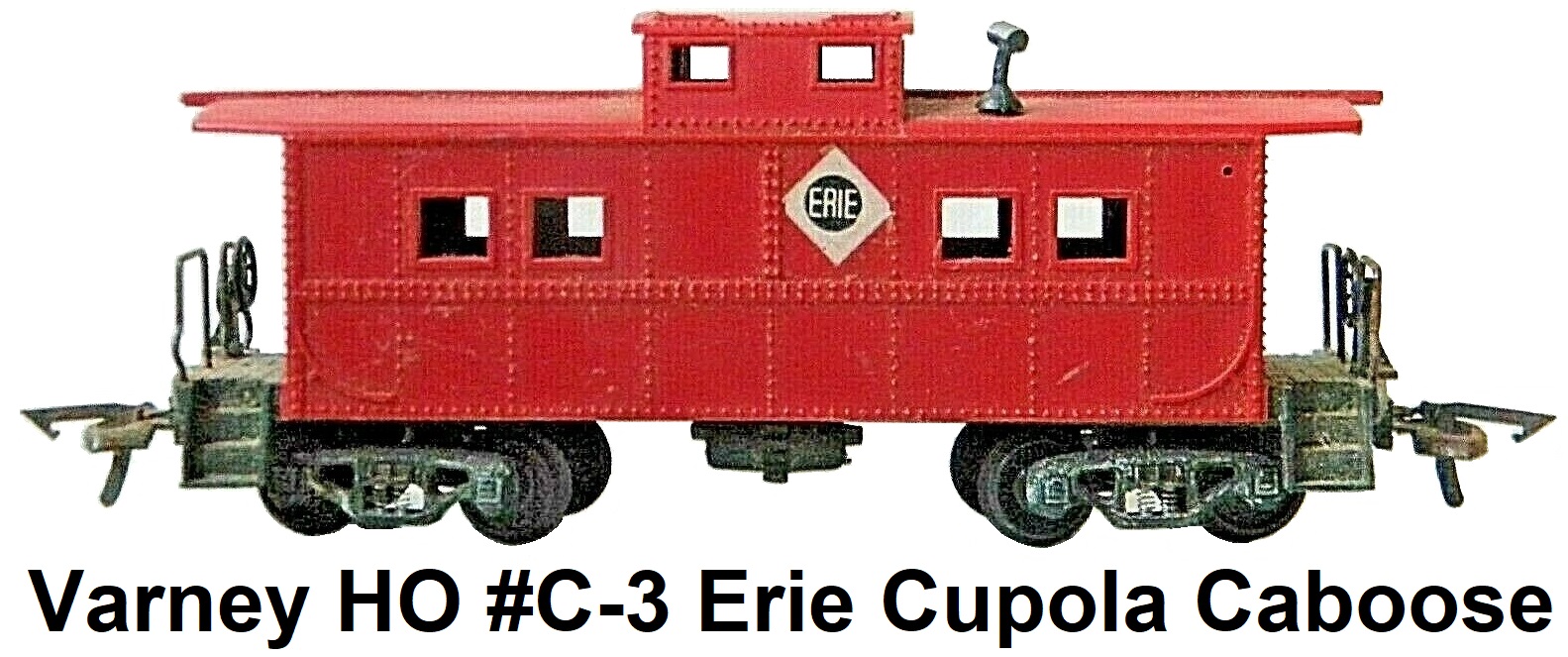 1950 was a banner year for HO, as Varney introduced new
plastic-bodied, injection molded freight cars. The 1950 catalog announced the new tank car kits that were prepainted and
lettered, with all the detail cast in the body and frame. The tank and dome were made of plastic. The underframe was a
single die-casting that came completely painted. The simulated Bettendorf trucks were also made of metal. The cars featured
lettered sides, sprung trucks, dummy couplers and draft gear. The kits sold for $2.50. The
new 2-bay 32 foot hopper cars consisted of a one-piece detailed colored plastic casting and a die-cast metal underframe.
They came pre-lettered. Metal sprung Bettendorf trucks and dummy couplers were included. Complete kits were $2.35. A covered
hopper was also offered that included a plastic roof with roof walk and 8 hatches. These kits were priced at $2.35. A new
plastic cupola caboose and a plastic bay-window caboose were also offered.
1950 was a banner year for HO, as Varney introduced new
plastic-bodied, injection molded freight cars. The 1950 catalog announced the new tank car kits that were prepainted and
lettered, with all the detail cast in the body and frame. The tank and dome were made of plastic. The underframe was a
single die-casting that came completely painted. The simulated Bettendorf trucks were also made of metal. The cars featured
lettered sides, sprung trucks, dummy couplers and draft gear. The kits sold for $2.50. The
new 2-bay 32 foot hopper cars consisted of a one-piece detailed colored plastic casting and a die-cast metal underframe.
They came pre-lettered. Metal sprung Bettendorf trucks and dummy couplers were included. Complete kits were $2.35. A covered
hopper was also offered that included a plastic roof with roof walk and 8 hatches. These kits were priced at $2.35. A new
plastic cupola caboose and a plastic bay-window caboose were also offered.
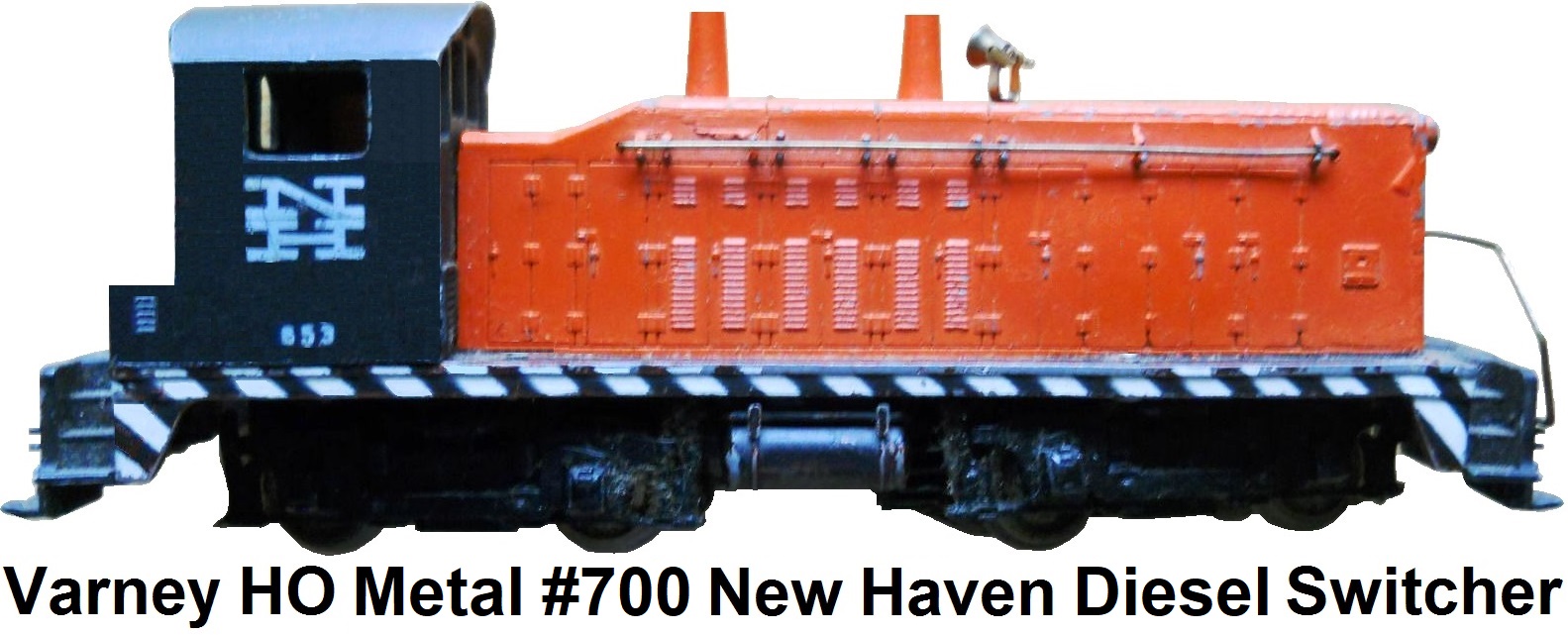 1950 also saw the release of a new diesel yard switcher kit - a GM 1000 HP model for $19.75. The
diesel switcher also utilized the Pittman DC-60 electric motor. It drove a truck worm shaft assembly that allowed both
the front and rear trucks to be driven by the motor, which was placed in the forward section of the shell above the front
truck. The diesel switcher's cast metal body came pre-painted in black, ready for lettering.
1950 also saw the release of a new diesel yard switcher kit - a GM 1000 HP model for $19.75. The
diesel switcher also utilized the Pittman DC-60 electric motor. It drove a truck worm shaft assembly that allowed both
the front and rear trucks to be driven by the motor, which was placed in the forward section of the shell above the front
truck. The diesel switcher's cast metal body came pre-painted in black, ready for lettering.
The business continued to grow, and by 1953 Varney was operating 2 glass walled production plants,
one located in Coral Gables, FL, and the other in Puerto Rico. At this point the firm employed more than 50 full-time
craftsmen, and together the 2 shops were producing more locomotives and cars than Baldwin and Pullman-Standard combined.
The use of plastic, as a replacement for metal, became more prevalent during this period. In 1954 Varney introduced a
plastic version of the 'Lil Joe' Dockside 0-4-0T loco. It came ready-to-run and featured an injection molded shell on a
die-cast metal chassis. 1955 saw Varney make a switch from die-cast F-3 diesel kits to special impact Polystyrene plastic
molded bodies. The 1955 catalog announced new F-3 diesel loco kits and a twin drive option that utilized a nylon worm shaft.
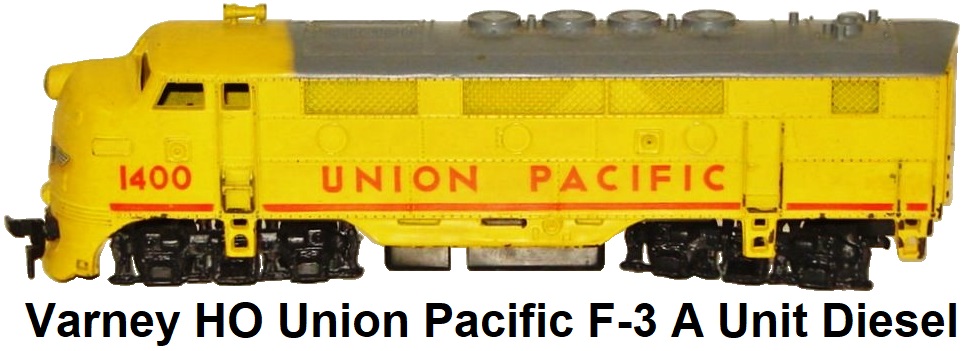
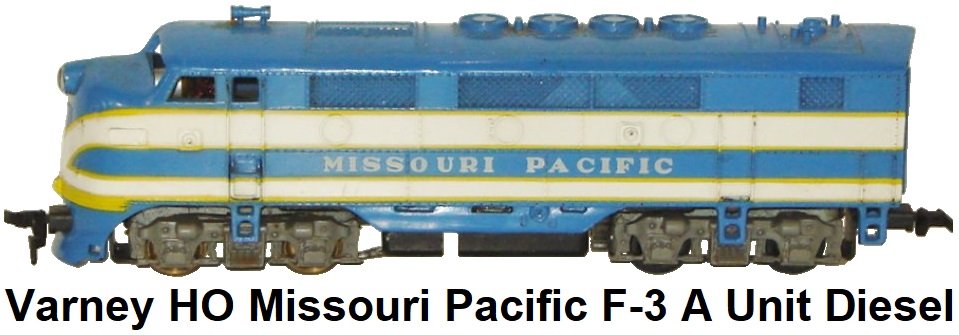
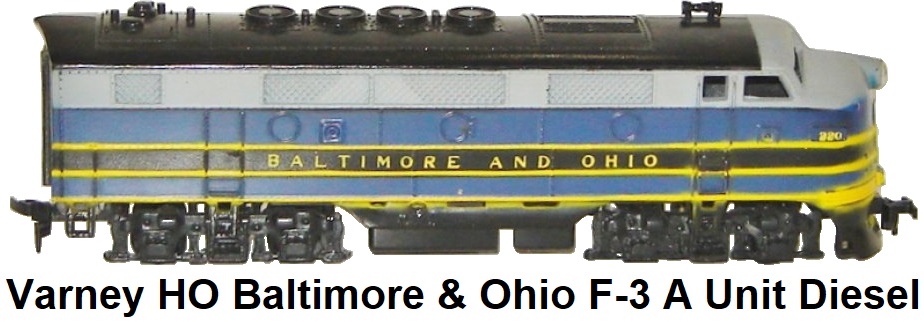
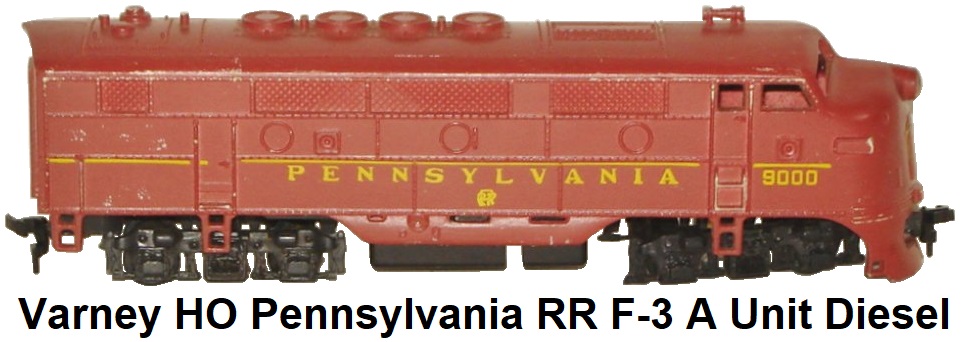
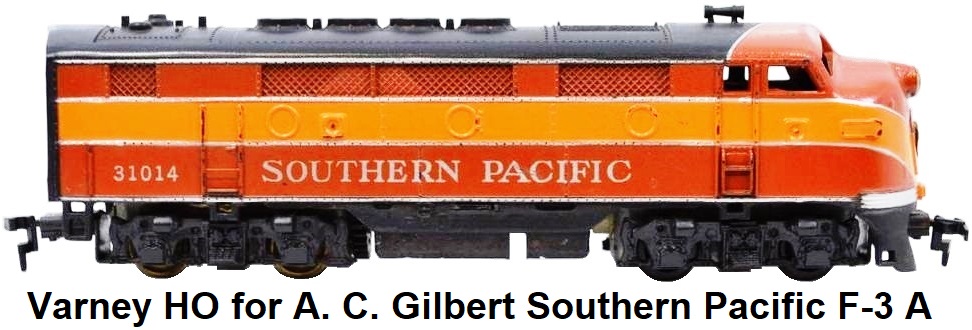 In 1955, the by then Miami, Florida based Varney Co. produced
a whole new and varied line of HO trains, for the A. C. Gilbert Company, makers of the 'S' gauge
American Flyer trains, called Gilbert HO. Varney provided A-B F-3 EMD diesels along with stock, hopper, a cement car,
oil tank cars, and a Reading style caboose. Many of the items were standard Varney production, but with A. C. Gilbert
numbering and window box packaging. Even though Gilbert had HO gauge trains in its product line since 1938, the 4 year
collaboration with Varney brought the highest quality and finest attempts at HO scale offerings. The highlight was
the Northern Pacific passenger set that was headed by Varney-produced F-3 diesels. Varney's
interest in helping Gilbert was somewhat personal, as Gordon Varney felt that by increasing Gilbert's
sales of ready-to-run HO, his line of HO kits would also benefit from the increased market demand.
Unfortunately, sales did not achieve the expected results.
In 1955, the by then Miami, Florida based Varney Co. produced
a whole new and varied line of HO trains, for the A. C. Gilbert Company, makers of the 'S' gauge
American Flyer trains, called Gilbert HO. Varney provided A-B F-3 EMD diesels along with stock, hopper, a cement car,
oil tank cars, and a Reading style caboose. Many of the items were standard Varney production, but with A. C. Gilbert
numbering and window box packaging. Even though Gilbert had HO gauge trains in its product line since 1938, the 4 year
collaboration with Varney brought the highest quality and finest attempts at HO scale offerings. The highlight was
the Northern Pacific passenger set that was headed by Varney-produced F-3 diesels. Varney's
interest in helping Gilbert was somewhat personal, as Gordon Varney felt that by increasing Gilbert's
sales of ready-to-run HO, his line of HO kits would also benefit from the increased market demand.
Unfortunately, sales did not achieve the expected results.
Varney for American Flyer HO Freight Cars
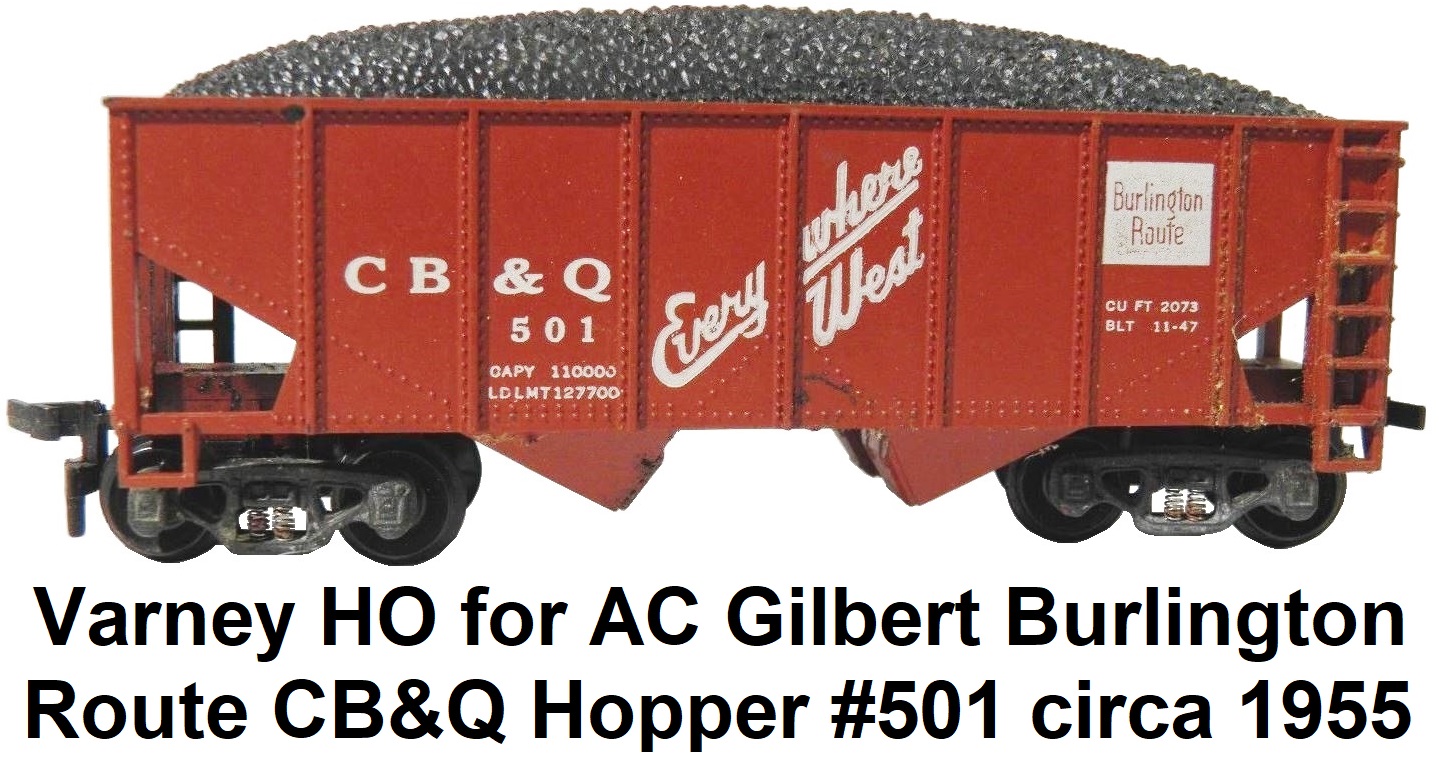
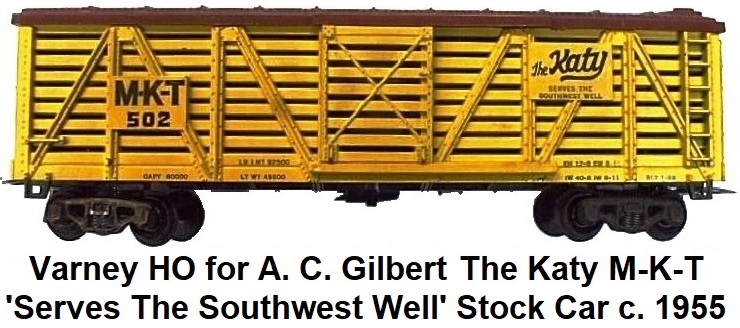

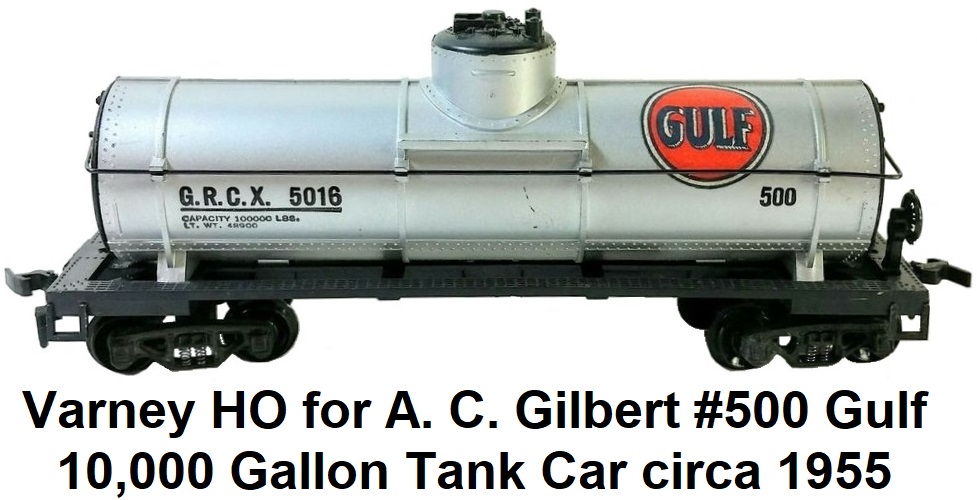

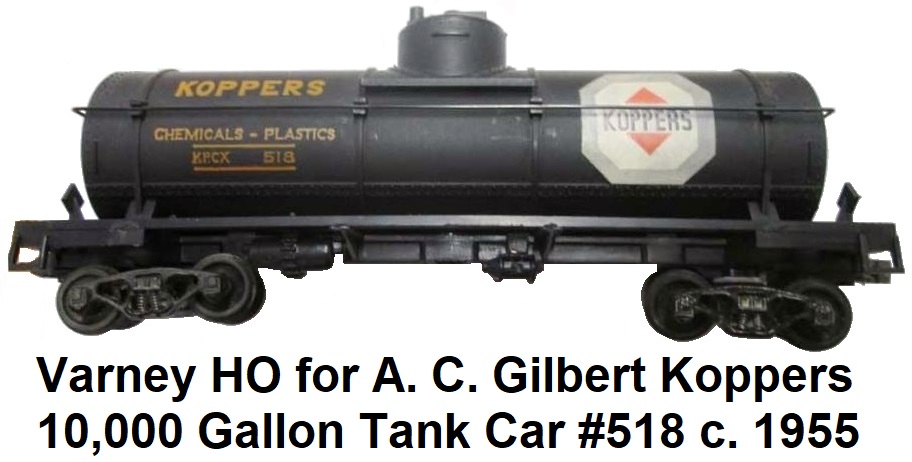
Varney catalogs promoted that by actual count there are 4,000 rivets on the 40' gondola, along with
lots of details on the bottom of the car. It came with fully assembled, sprung trucks and sold for $1.90 in 1955. Prior to
the change to plastic molded gondolas, the kits featured embossed, lettered and colored aluminum sides and ends that
interlocked. Ladders and brake wheel were stamped metal. The air brake system and couplers were made of Tenite. Steps and
grab irons were made of formed wire.
Varney 40' Gondolas - Styrene Plastic Molded Built-up Kits & Ready-to-Run
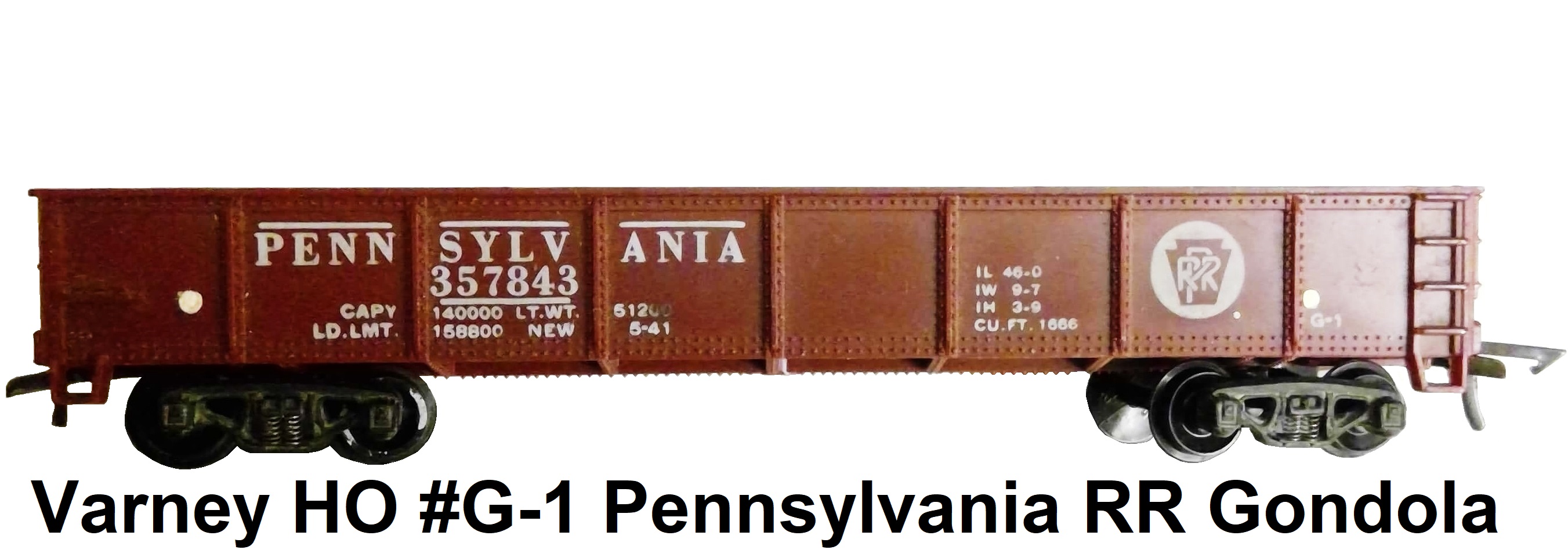
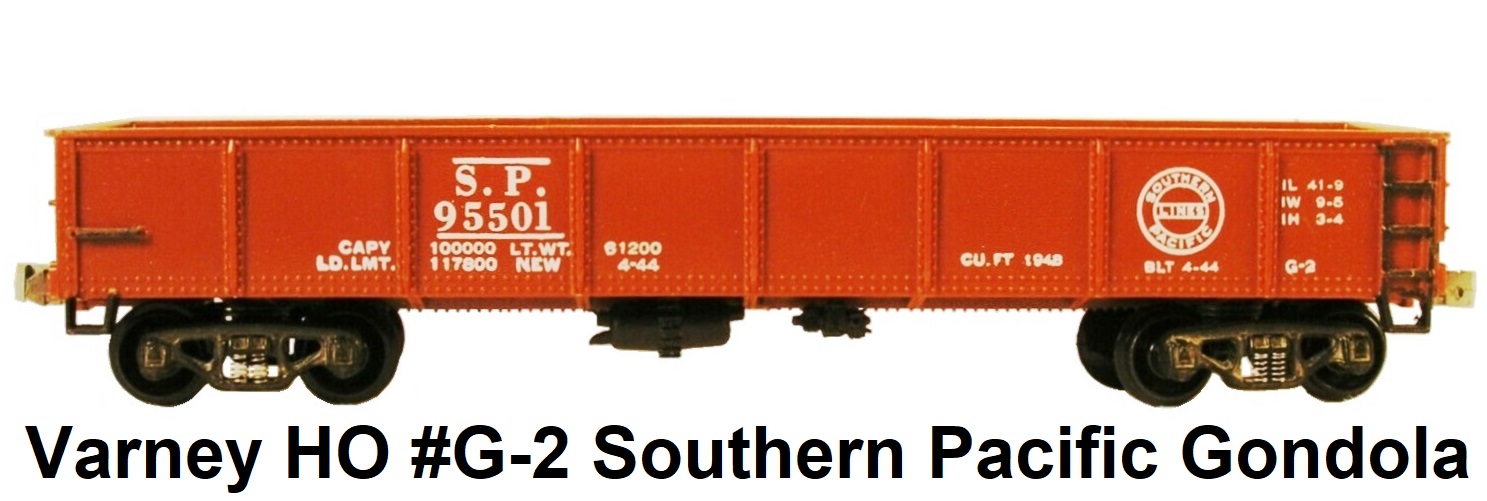
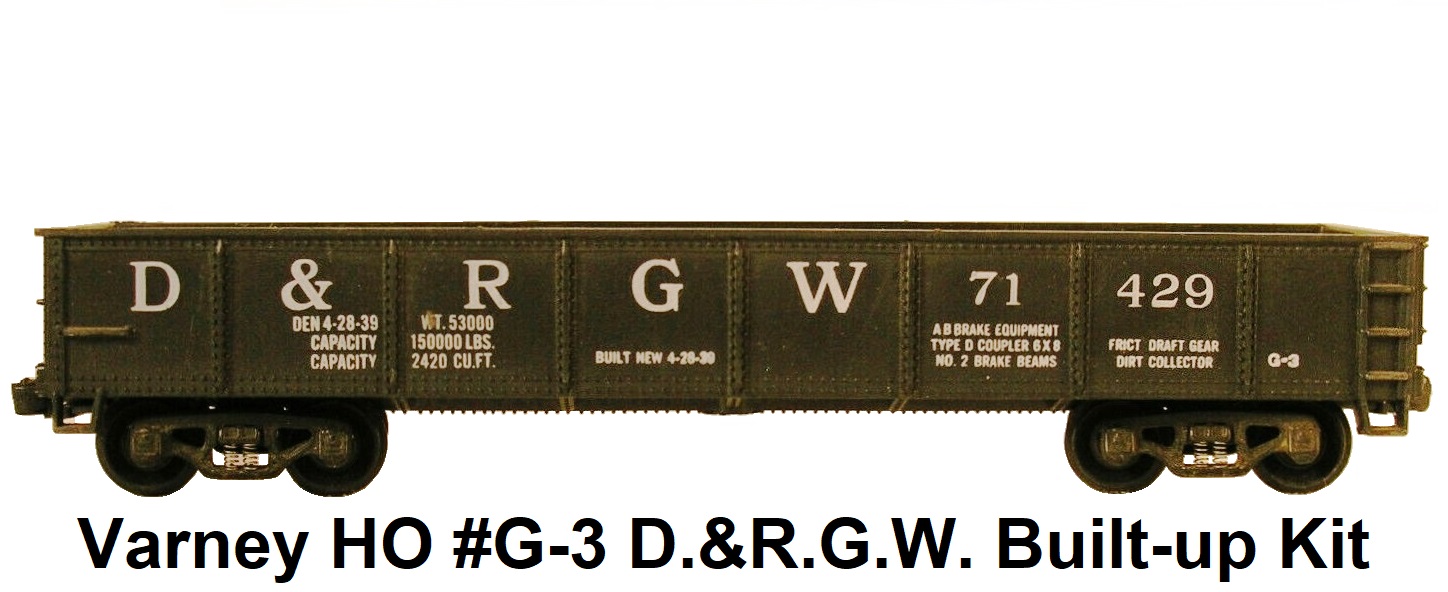
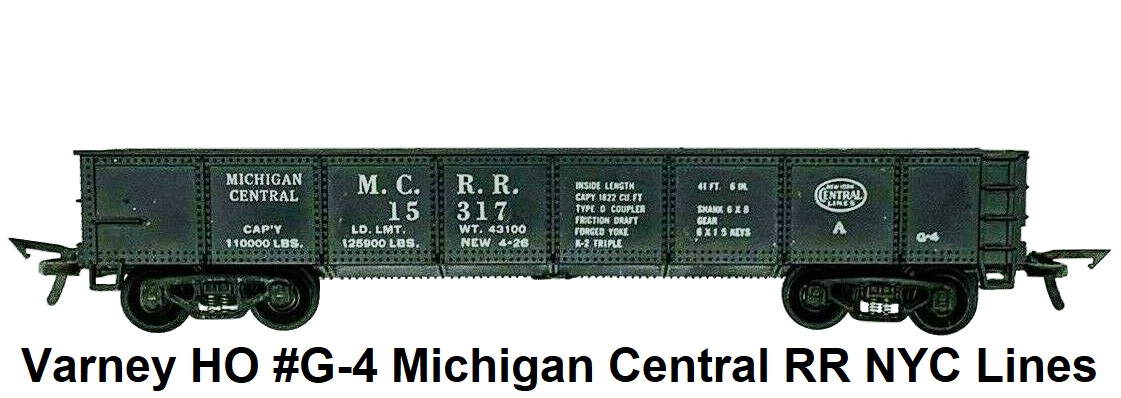

In 1957, Varney introduced plastic molded woodside reefer kits.
Varney Plastic Molded 40' Woodside Reefer Built-up Kits & Ready-to-Run
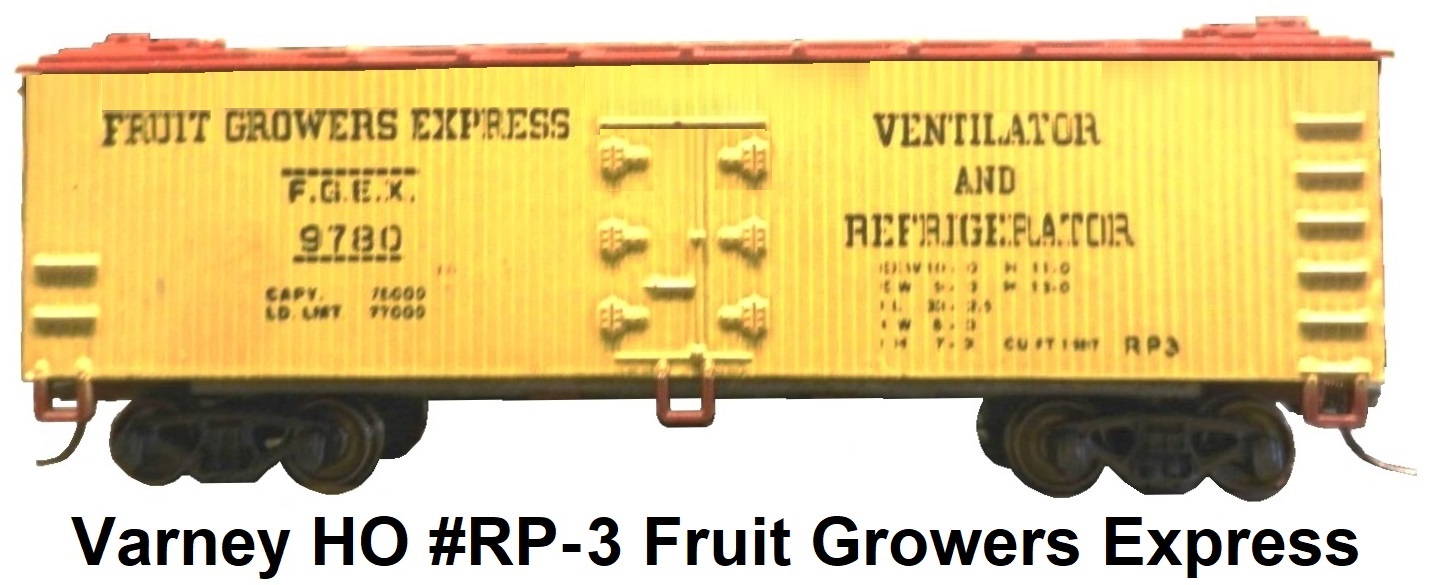
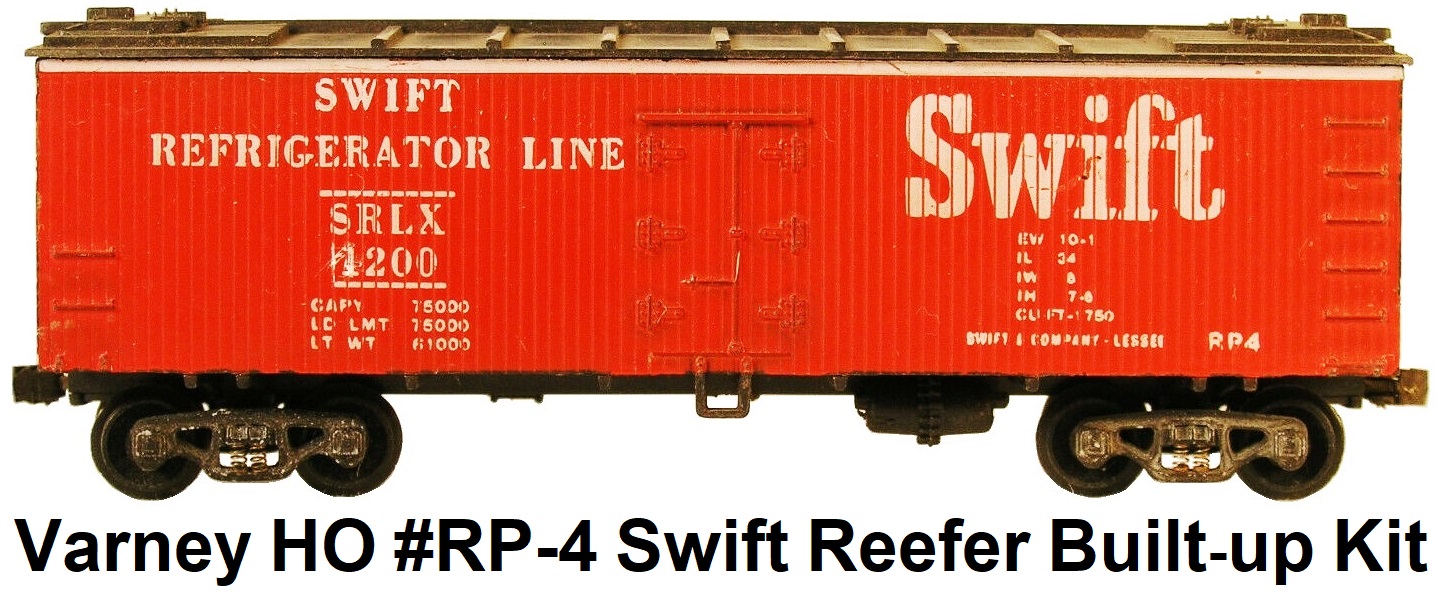
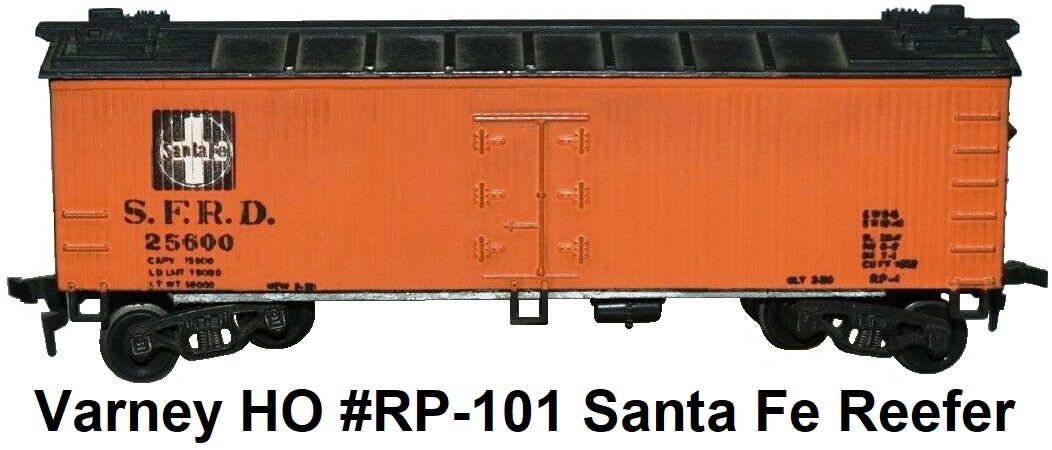
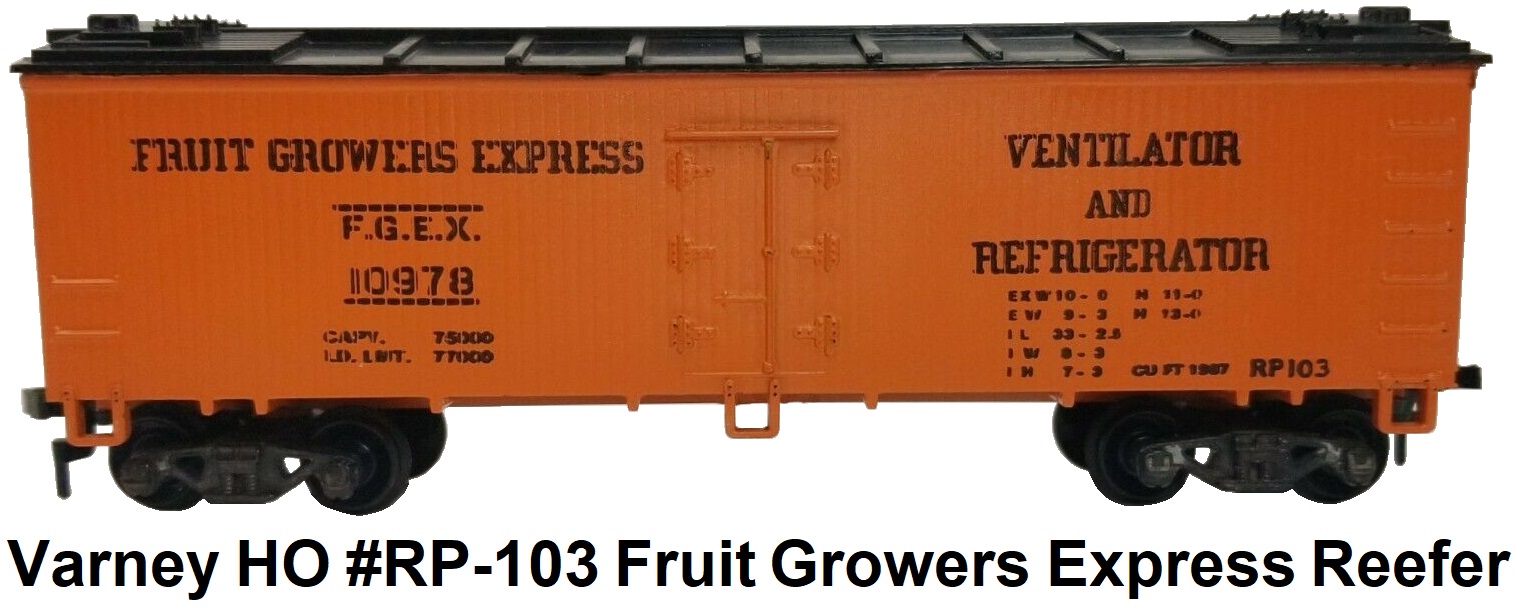
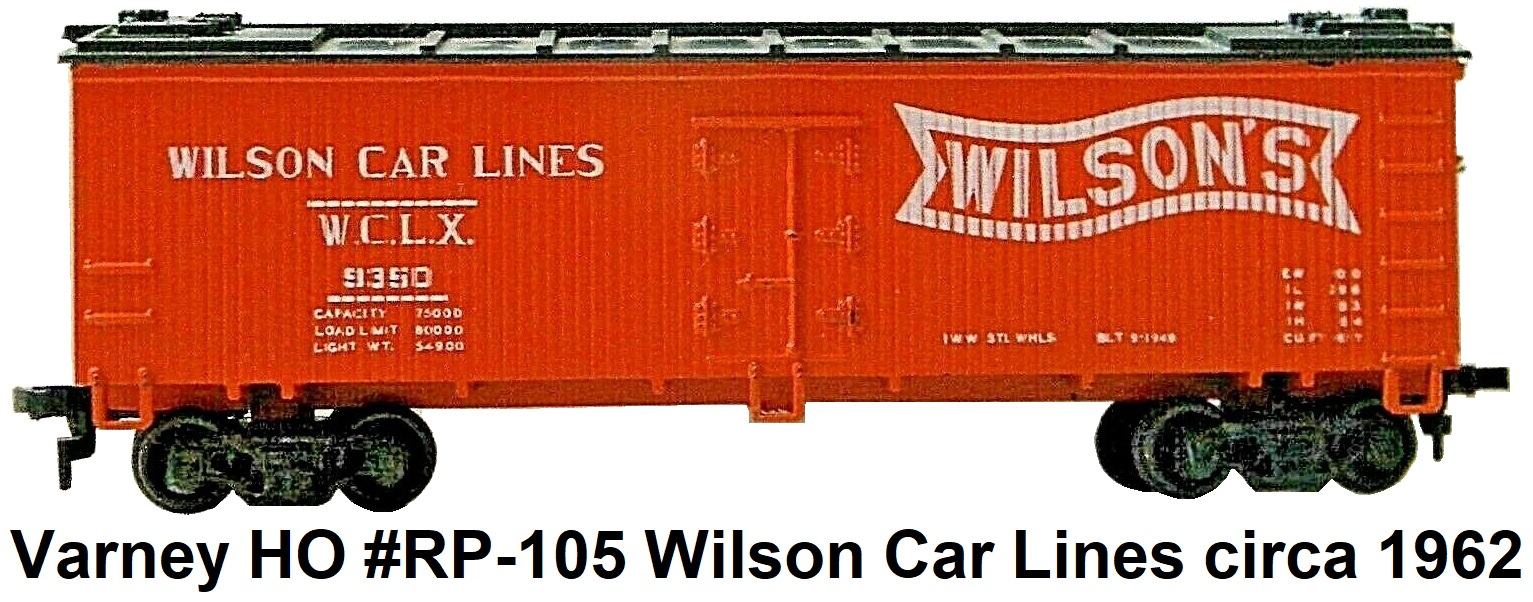
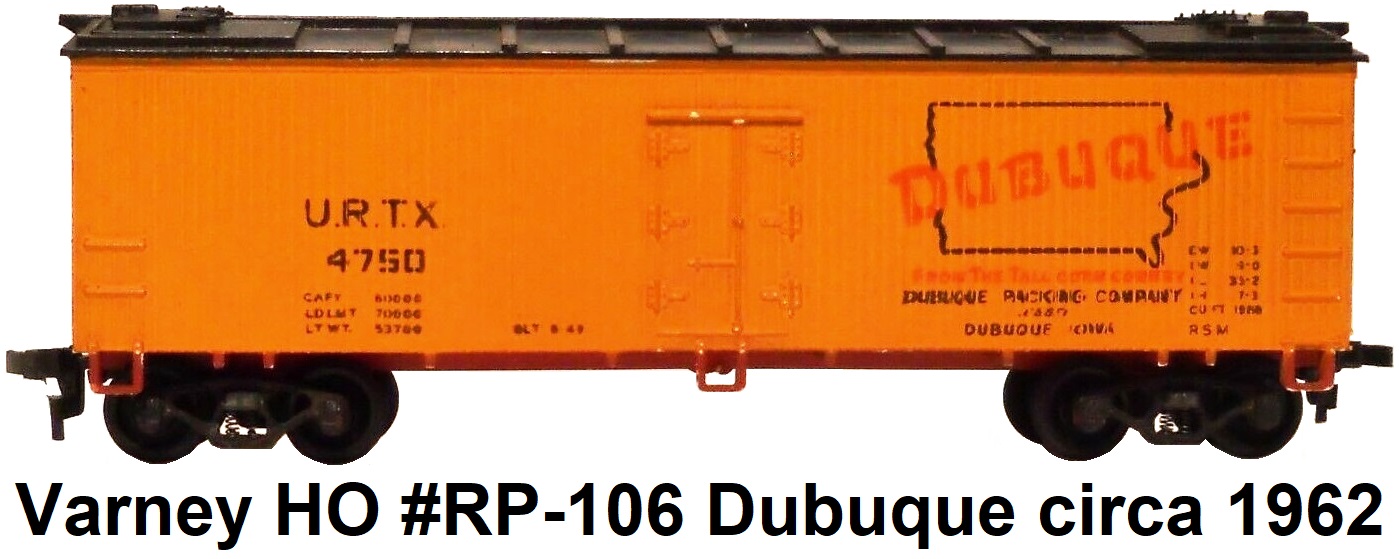
 Gordon Varney sold the company in 1960 to Sol Kramer of Life-Like, and it was moved to Baltimore, MD.
Around this time Varney/Hobbyline plastic passenger cars were supplied to Penn Line for their HO
train sets. Varney also made the C&O hopper and Sinclair tank car for Penn Line. The 1962 Varney catalog announced a new
KM-1 electric motor that was made in Japan. A full 5-year guarantee was also advertised. Many Varney items were now being
offered in either kit form or fully assembled, ready-to-run.
Gordon Varney died in 1965. In 1968 Mehano of Yugoslavia produced an RS-11 diesel in HO for Varney. It would be the last
new diesel release for the Varney line. The model trains continued to be produced
under the Varney name until March 1970, when the branding was finally changed to 'Life-Like.' The HO RS-11 was featured as the
cover model for Life-Like's first full-line HO product catalog in 1970. Around this time, Varney
also put out a nice die-cast HO GG-1 Electric locomotive made from tooling that Sol Kramer had acquired from
Penn Line. In 1985, the Model Railroad Industry
Association, Inc. named Gordon Varney a Pioneer of Model Railroading.
Gordon Varney sold the company in 1960 to Sol Kramer of Life-Like, and it was moved to Baltimore, MD.
Around this time Varney/Hobbyline plastic passenger cars were supplied to Penn Line for their HO
train sets. Varney also made the C&O hopper and Sinclair tank car for Penn Line. The 1962 Varney catalog announced a new
KM-1 electric motor that was made in Japan. A full 5-year guarantee was also advertised. Many Varney items were now being
offered in either kit form or fully assembled, ready-to-run.
Gordon Varney died in 1965. In 1968 Mehano of Yugoslavia produced an RS-11 diesel in HO for Varney. It would be the last
new diesel release for the Varney line. The model trains continued to be produced
under the Varney name until March 1970, when the branding was finally changed to 'Life-Like.' The HO RS-11 was featured as the
cover model for Life-Like's first full-line HO product catalog in 1970. Around this time, Varney
also put out a nice die-cast HO GG-1 Electric locomotive made from tooling that Sol Kramer had acquired from
Penn Line. In 1985, the Model Railroad Industry
Association, Inc. named Gordon Varney a Pioneer of Model Railroading.
Versions of many former Varney products remained on the market in the Bowser
Manufacturing and Life-Like lines. This includes the Aerotrain in plastic that
Gordon Varney created the molds for, and that Bowser has used over the years as a basis for its
Aerotrain models in HO Scale. Bowser also continued to produce the Old Lady (2-8-0), Casey Jones (4-6-0), and
'Lil Joe' Docksider 0-4-0T steam locos. Varney's plastic injection molded freight cars continued to be produced
by Life-Like and then by Walthers after they acquired the company in 2005.
Varney 40' Single Door Steel Type Box Cars - Plastic Molded Built Up Kits & Ready-to-Run
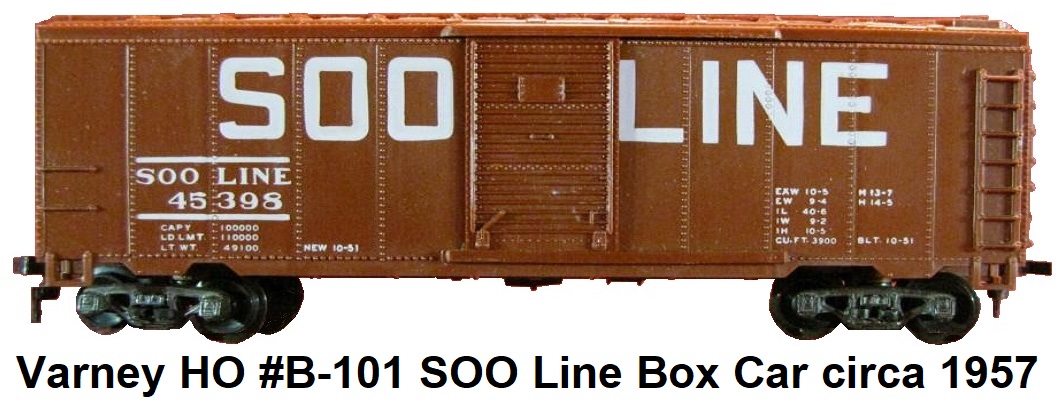
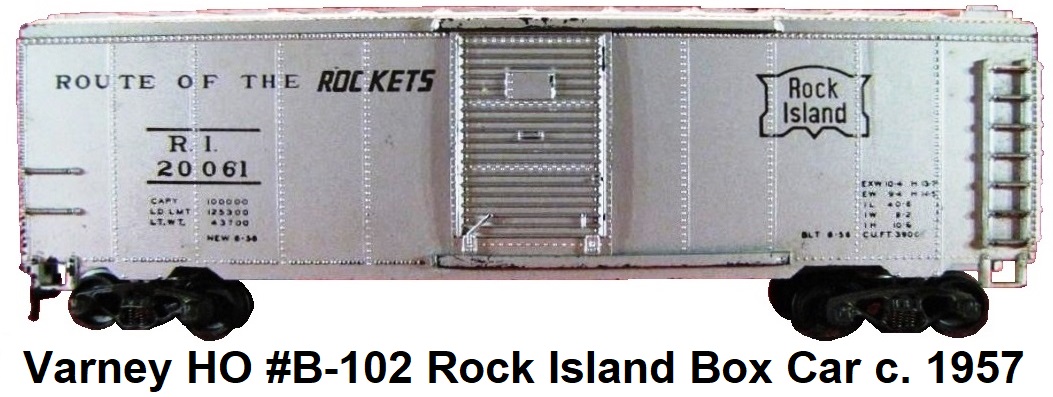

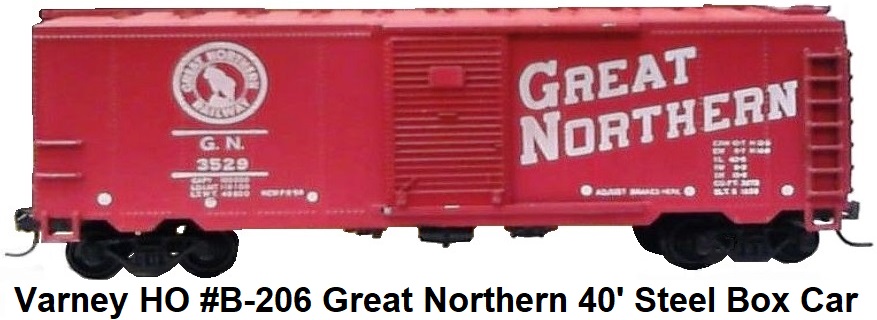
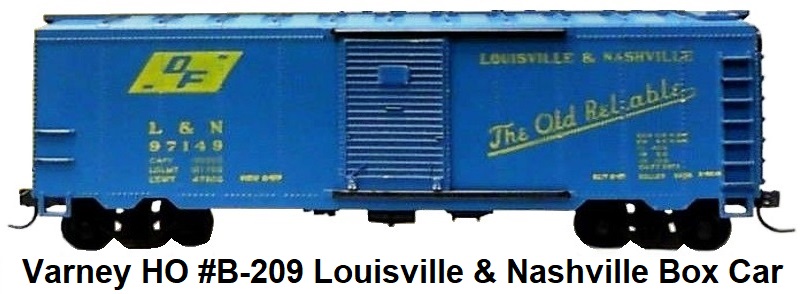
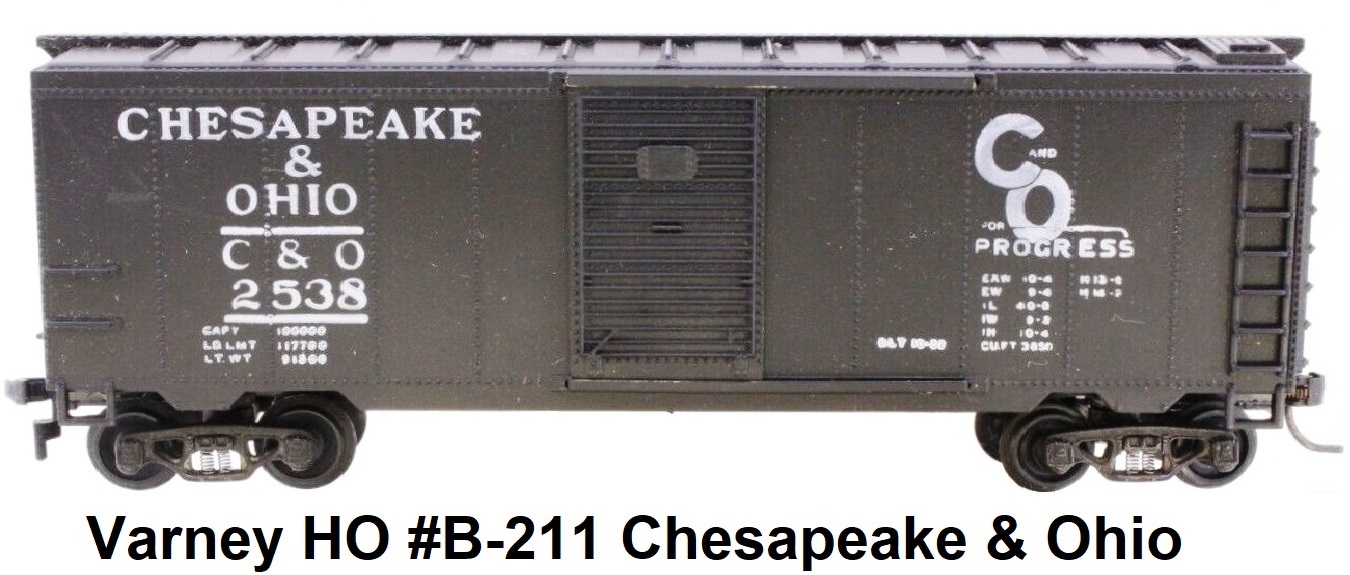
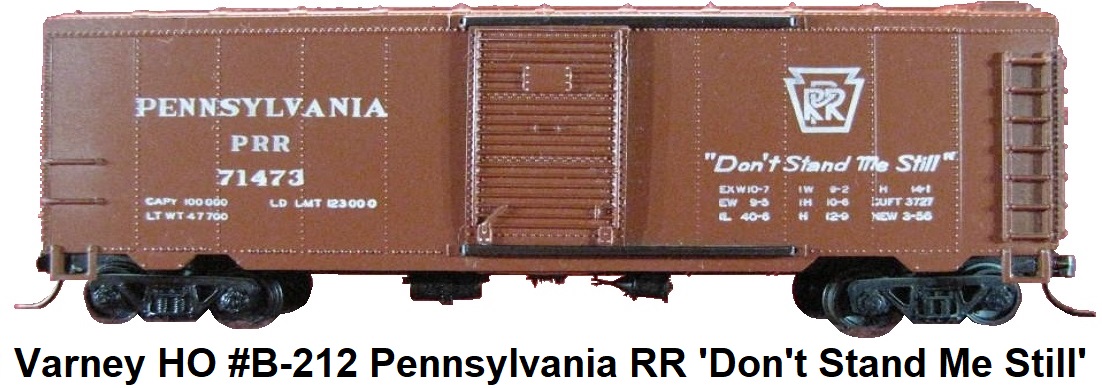
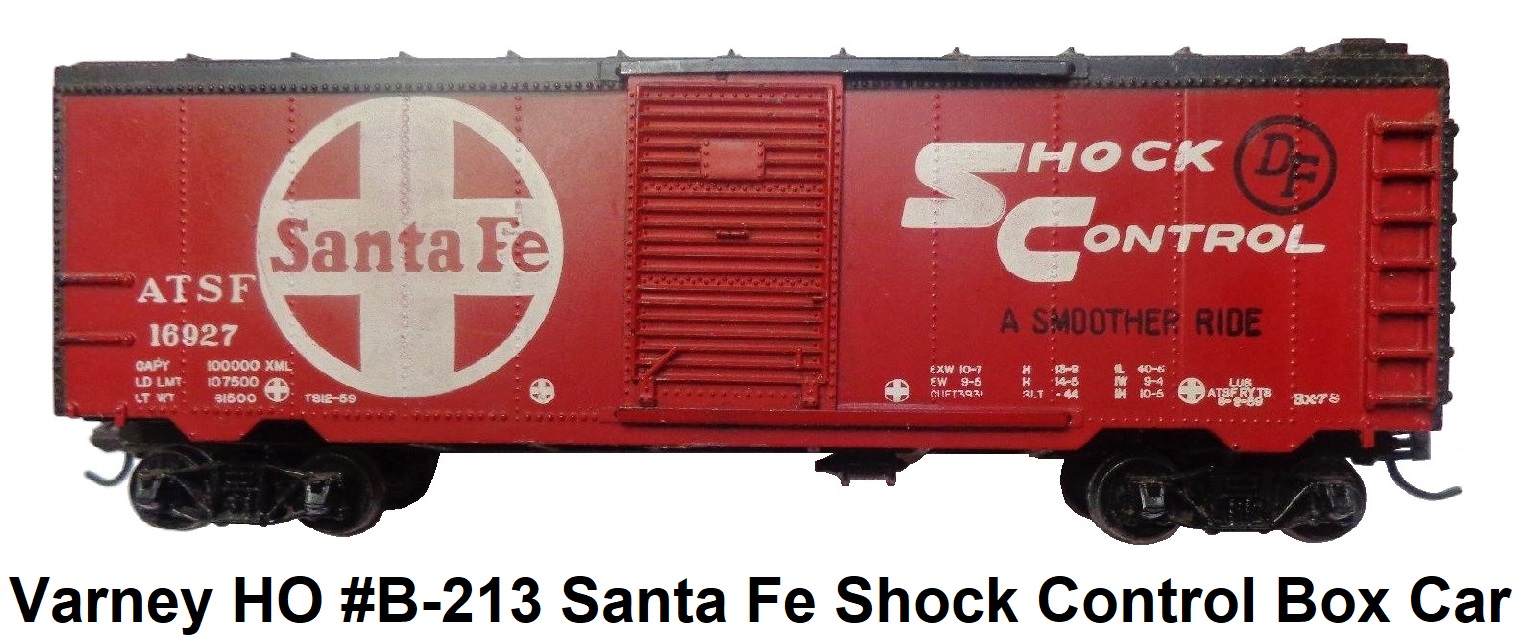
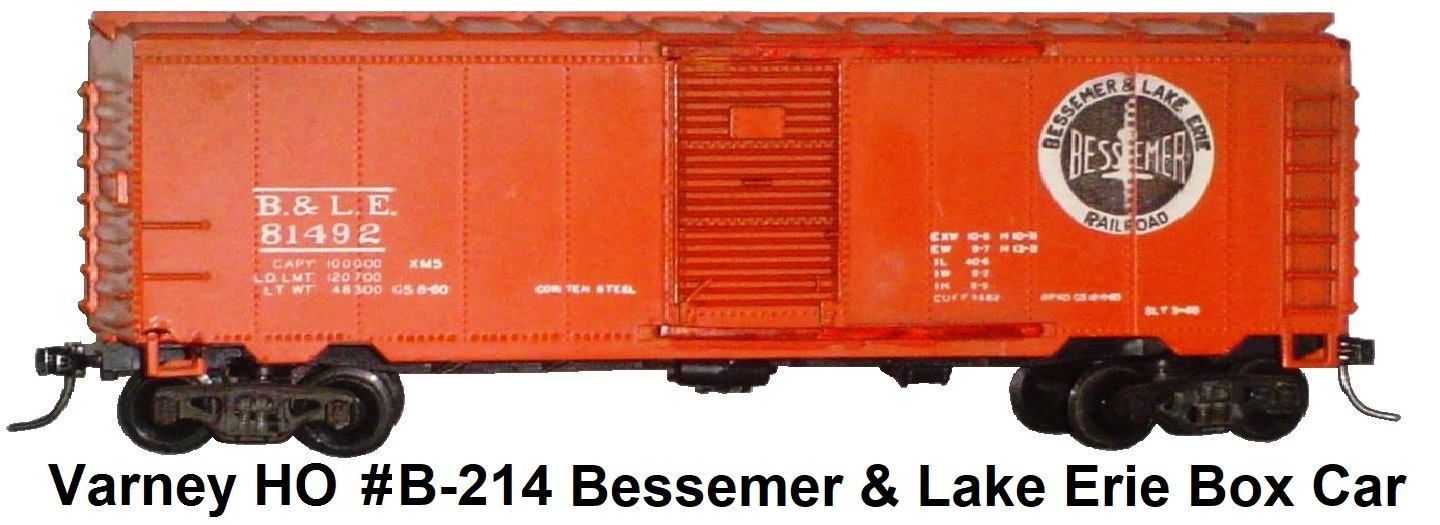
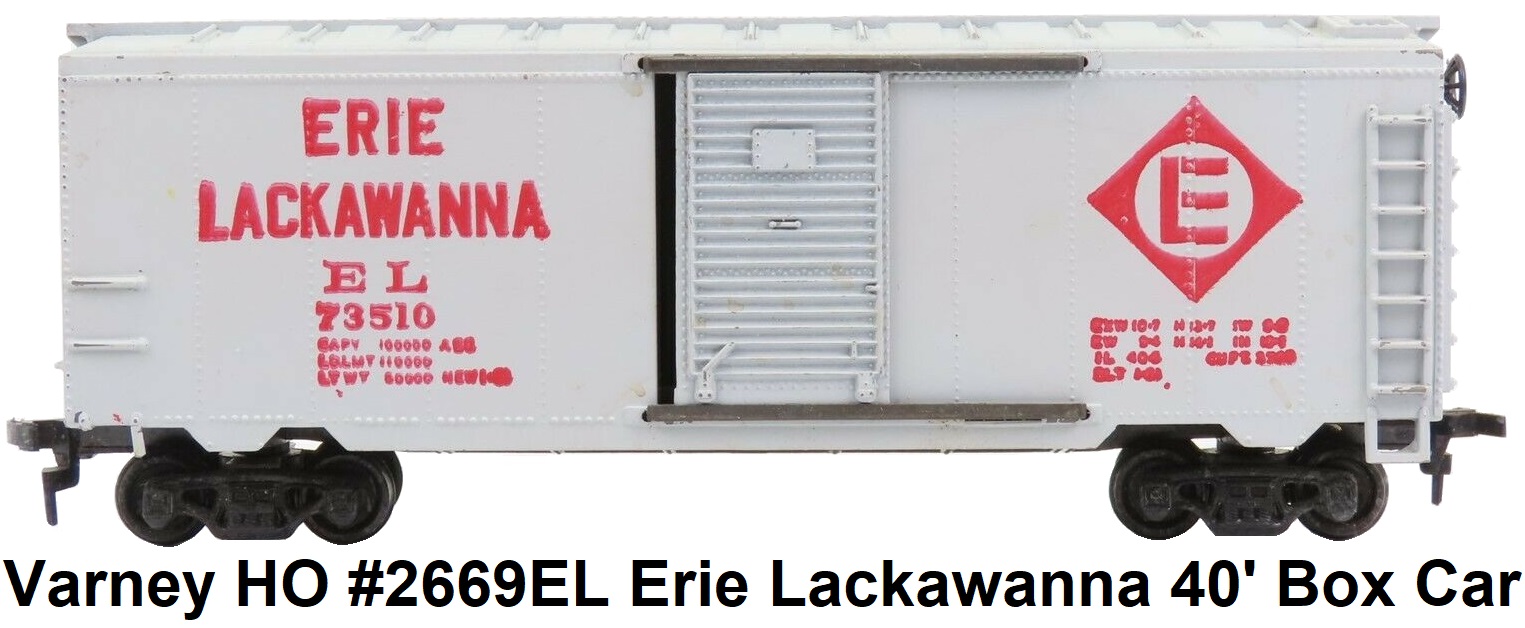
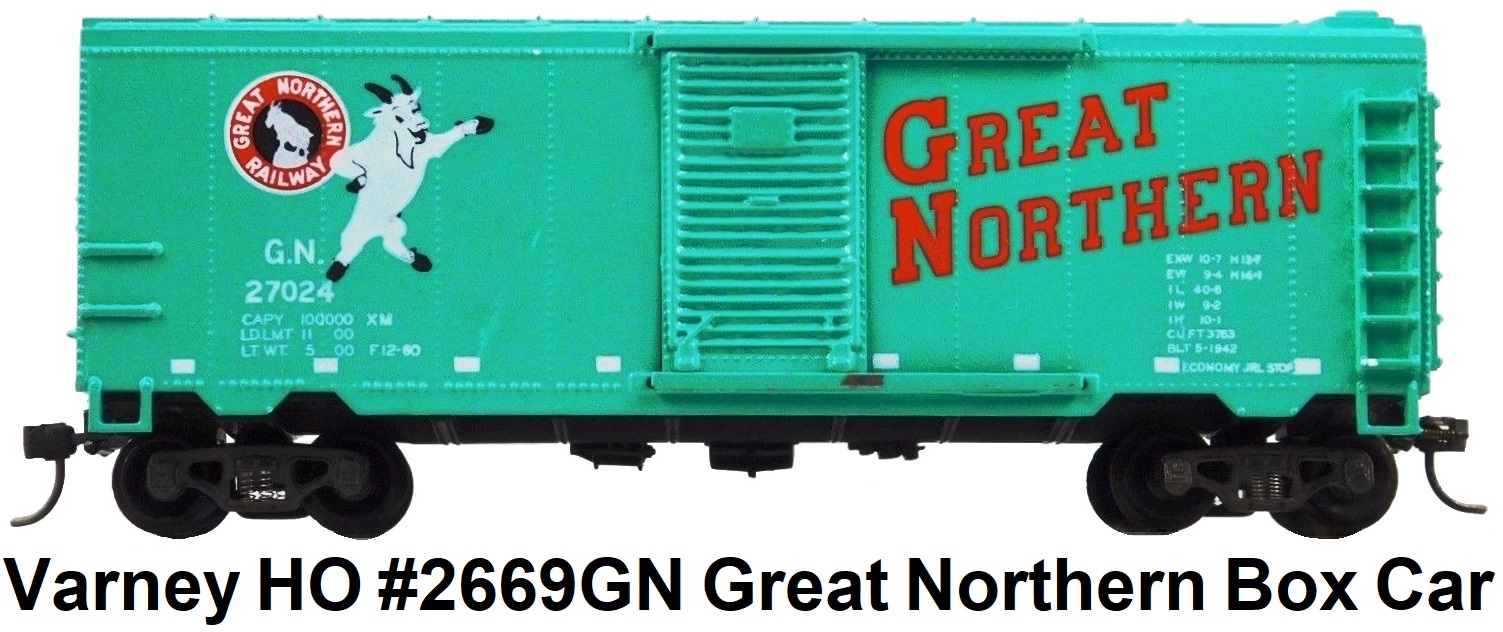
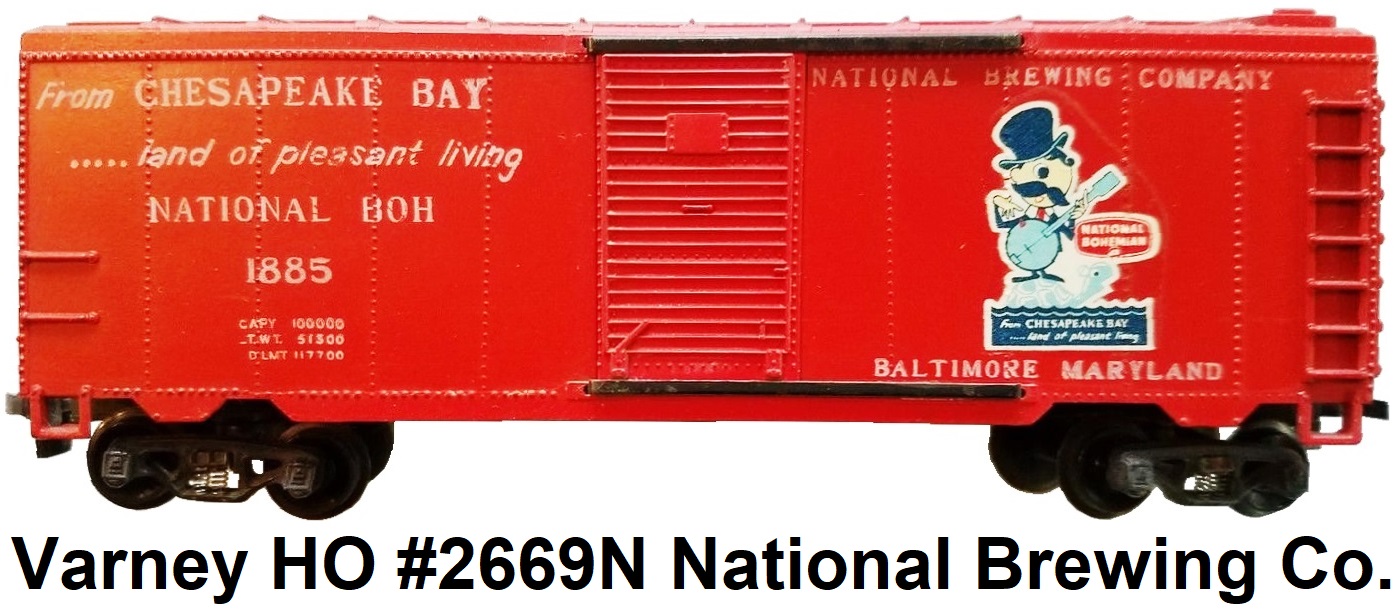
Today, train collectors actively seek and prize the Varney products
produced during the 10 year post war era. Some engines sell in the $500 range, which is unusual for HO
gauge trains. Varney's early brass locomotives are very rare and are highly sought after by collectors, as well as by
modellers who take joy in the work of restoration of these antiques. The locos that are rarest and most sought after include
the 2-8-8-4 Yellowstone, 4-8-4 Northern, and the 4-6-4 Hudson. Another very rare item from Varney is the streamlined 4-6-2
 Pacific loco with its especially rare wood fiber streamlined tender with 6-wheel Commonwealth tender trucks. The streamlined
Pacific becomes an even rarer item when the 8 matching wood fiber streamlined passenger cars are found with it. This
set was depicted in a 2-page spread in the 1940 catalog. The cars were offered in 3 color schemes. These were orange and red,
for the Southern Pacific Daylight, blue and dark blue for the Baltimore & Ohio, and Tuscan red and maroon for the Pennsylvania
RR Broadway limited. The 8 full scale length passenger cars were the PA1 baggage express, PA2 baggage mail, PA3 combination,
PA4 day coach, PA5 diner, PA6 Pullman roomette, PA7 Pullman bedroom compartment/drawing room, and PA8 observation. Literature
stated that the streamlined cars were developed using actual plans of these trains. A complete set of all 8 cars was offered
for $19.50. Individual cars were $2.75 each. The streamlined Pacific could be modified to a Hudson with the replacement of
the 2-wheel trailing truck with a 4-wheel trailing truck. The streamlined Pacific kit was priced at $24.50 loco only, $32.25
with tender, or $65 finished, with tender and painted to match any of the 3 streamlined car colors.
Pacific loco with its especially rare wood fiber streamlined tender with 6-wheel Commonwealth tender trucks. The streamlined
Pacific becomes an even rarer item when the 8 matching wood fiber streamlined passenger cars are found with it. This
set was depicted in a 2-page spread in the 1940 catalog. The cars were offered in 3 color schemes. These were orange and red,
for the Southern Pacific Daylight, blue and dark blue for the Baltimore & Ohio, and Tuscan red and maroon for the Pennsylvania
RR Broadway limited. The 8 full scale length passenger cars were the PA1 baggage express, PA2 baggage mail, PA3 combination,
PA4 day coach, PA5 diner, PA6 Pullman roomette, PA7 Pullman bedroom compartment/drawing room, and PA8 observation. Literature
stated that the streamlined cars were developed using actual plans of these trains. A complete set of all 8 cars was offered
for $19.50. Individual cars were $2.75 each. The streamlined Pacific could be modified to a Hudson with the replacement of
the 2-wheel trailing truck with a 4-wheel trailing truck. The streamlined Pacific kit was priced at $24.50 loco only, $32.25
with tender, or $65 finished, with tender and painted to match any of the 3 streamlined car colors.
Varney 40' Stock Cars - Plastic Molded Built-up Kits & Ready-to-Run
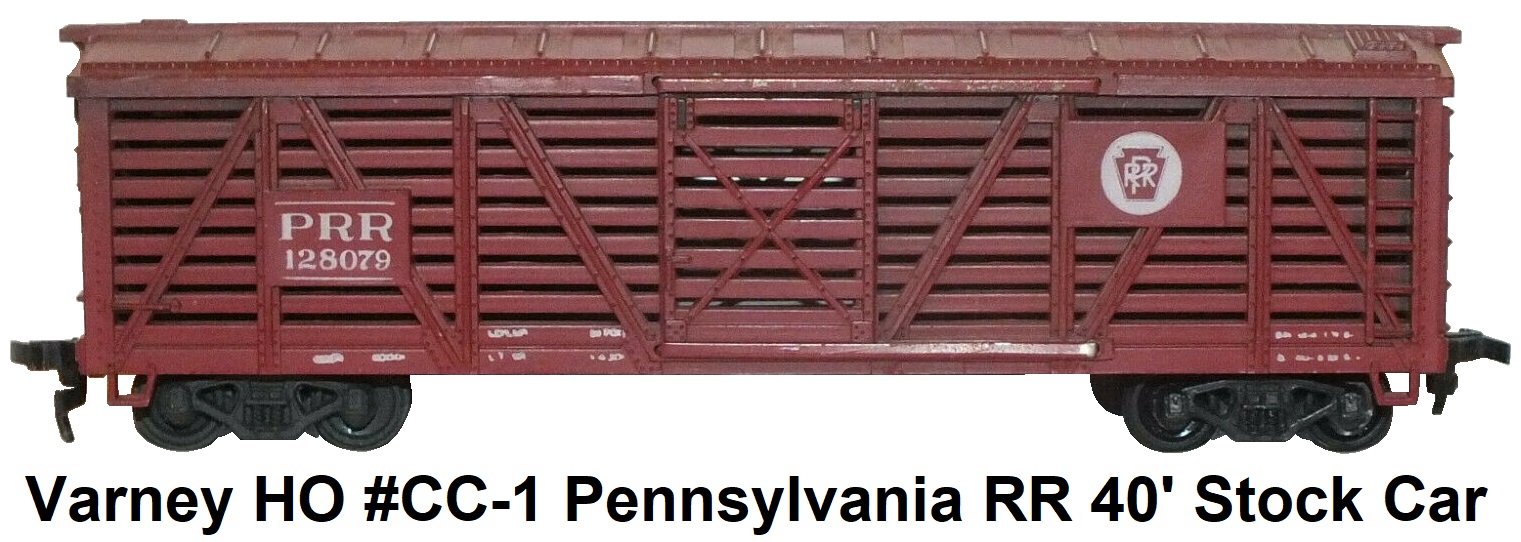
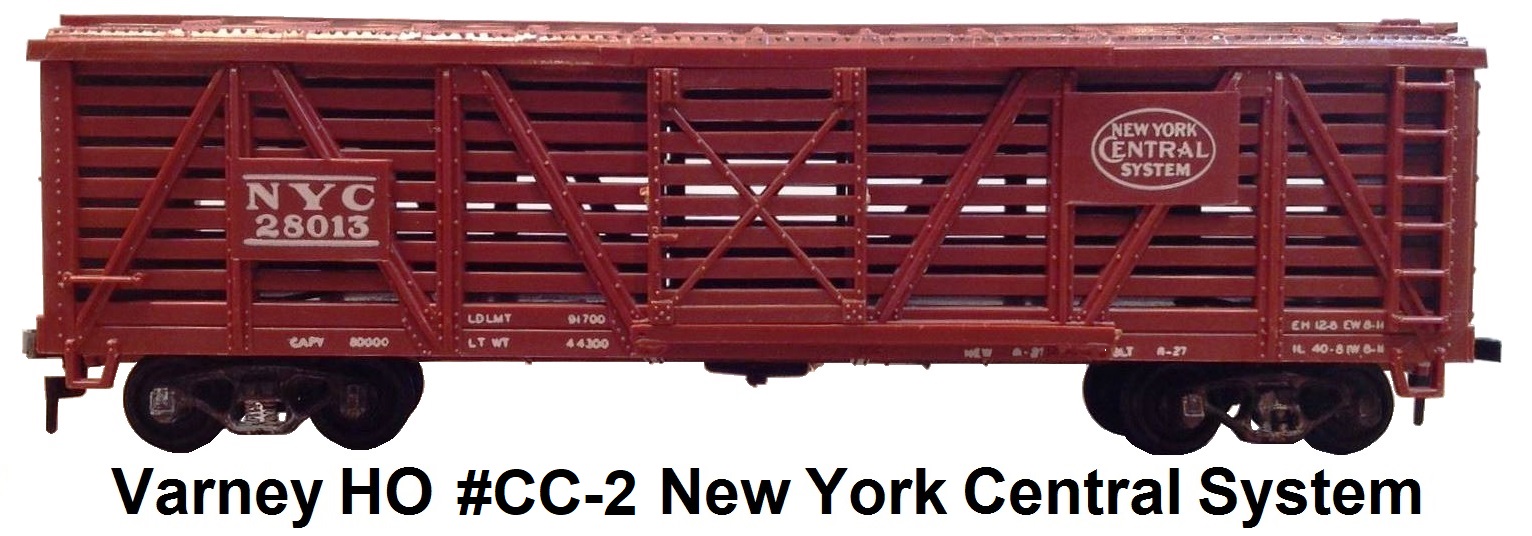
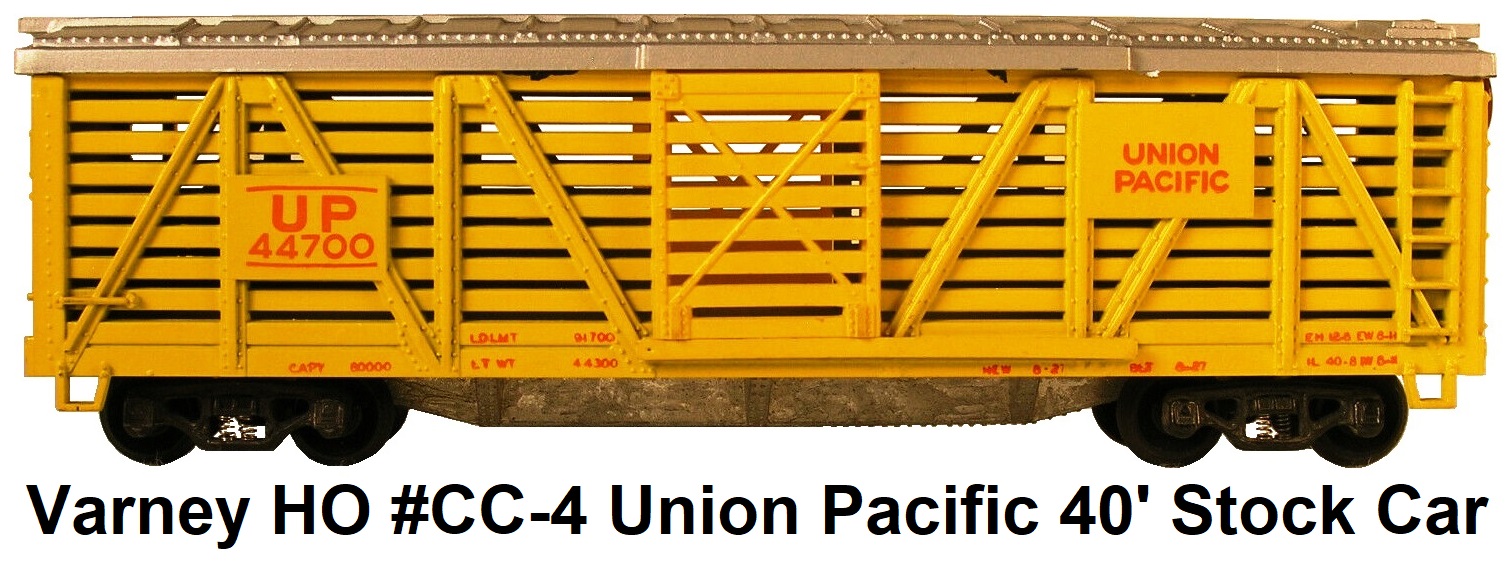


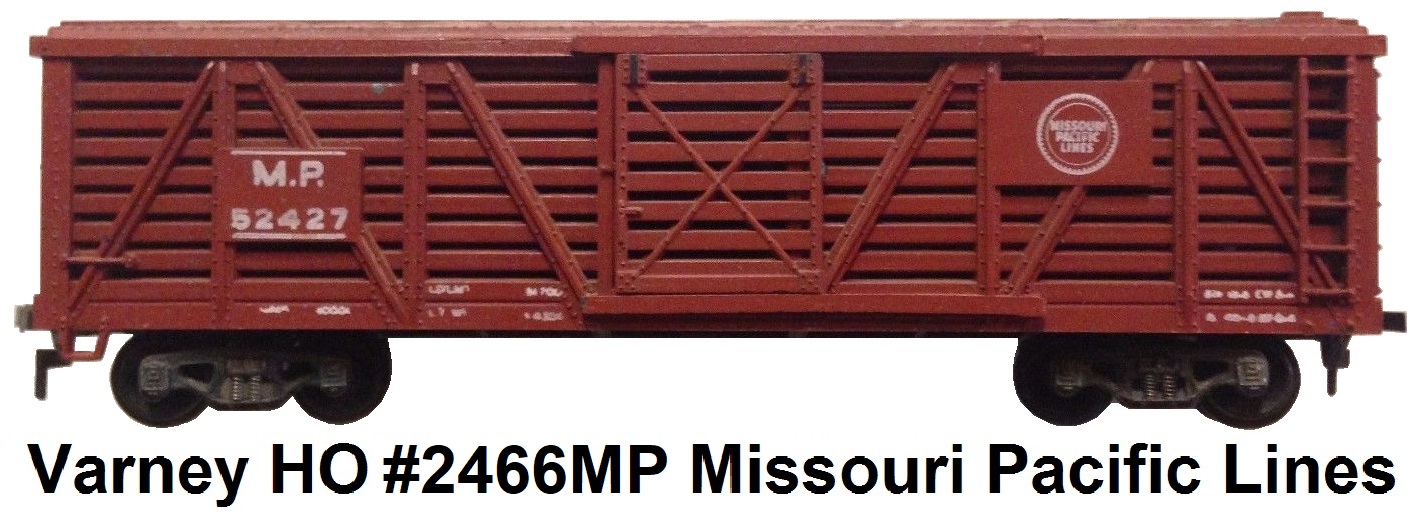

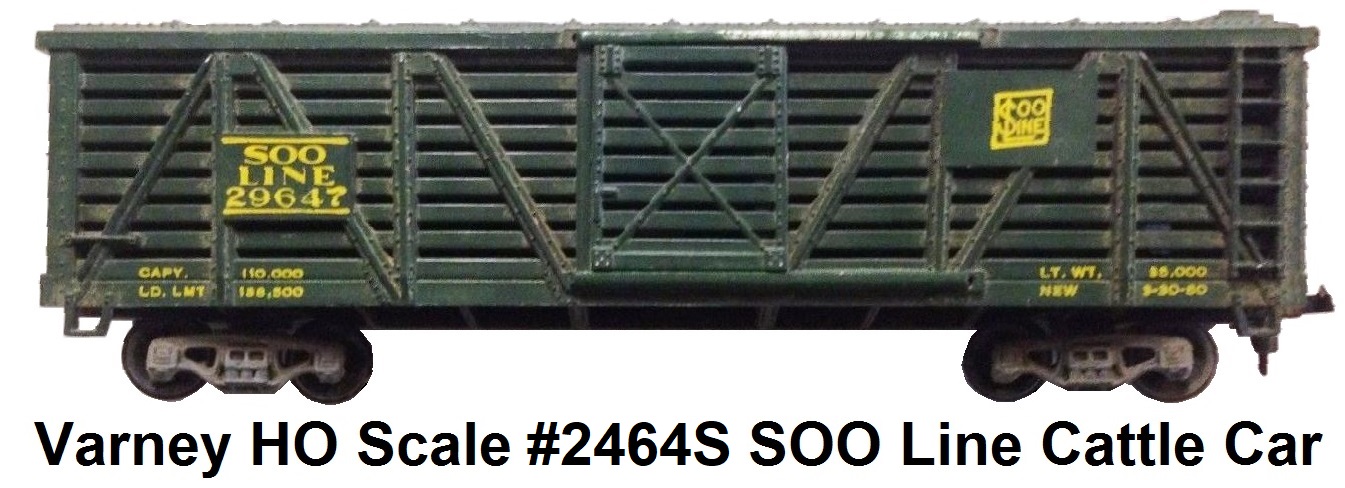
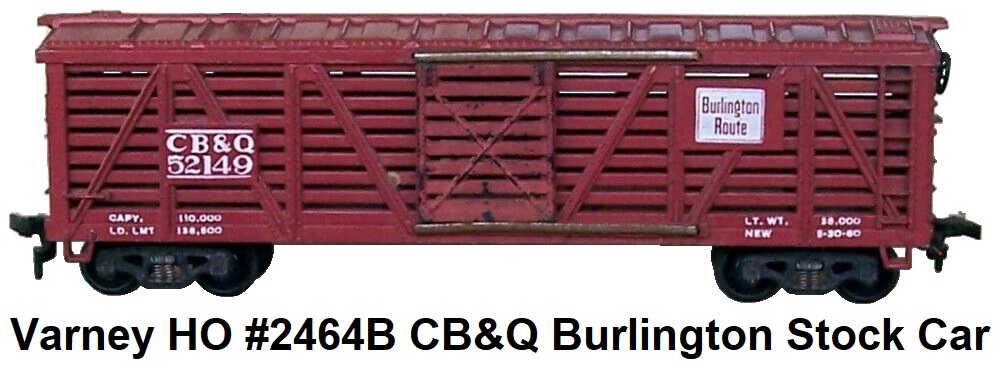
The early Varney 40' stock car kits from the 1940's had open work sides made of Tenite molded in a single
piece that included the letter boards. The floor, roof and scribed roof walk were made of wood. The airbrake system was also
made of Tenite. The stock car featured die-cast metal dummy couplers, end sills, and roof walk end platforms.
Link to Varney Catalogs on line.
